Please select your jurisdiction from the list below
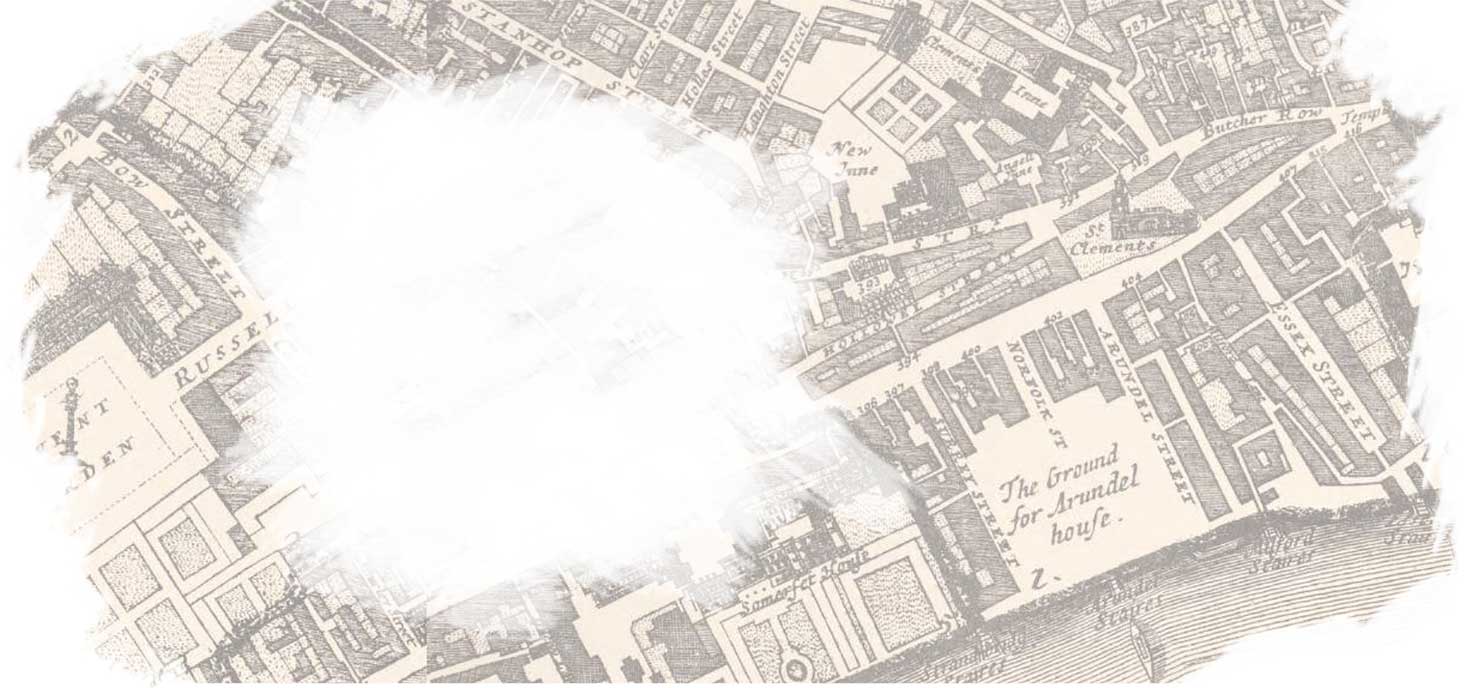
c1640
ede's heritage
The business which later became Ede robemakers was established by the Shudall family during the seventeenth century.
Read Morec1640
ede's heritage
The Shudalls operated as respected tailors, robemakers and haberdashers from the area around Holywell Street, near the Strand, the centre of the tailoring trade in London during the seventeenth century.
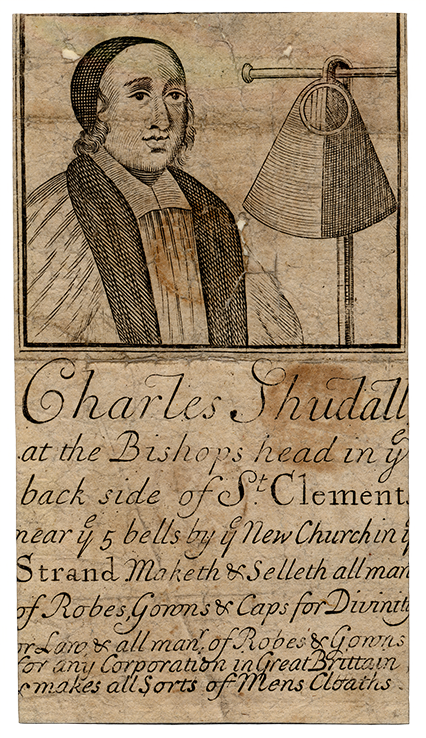
Charles Shudall trade card, c1730.
© City of Westminster Archives
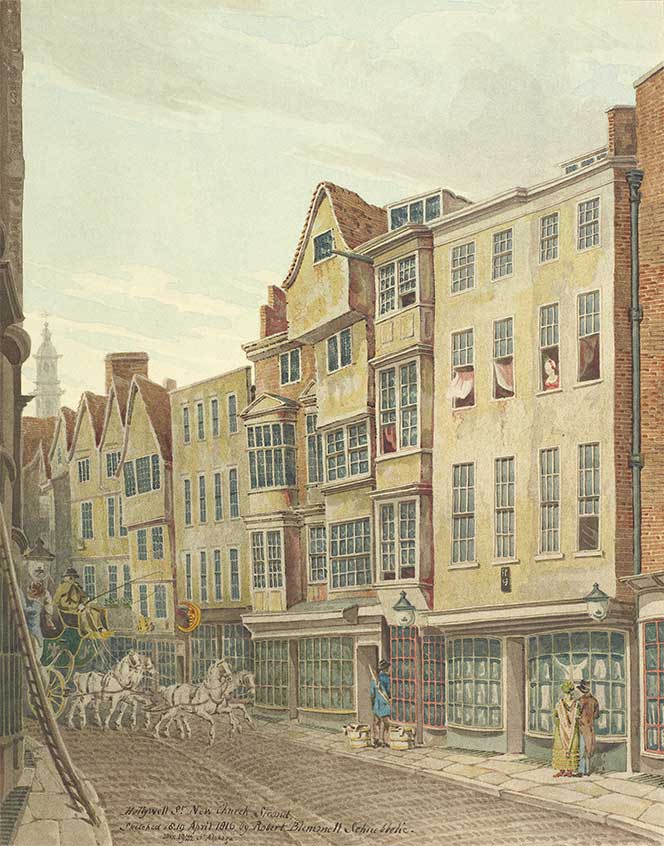
Holywell Street, 1816. © London Metropolitan Archives
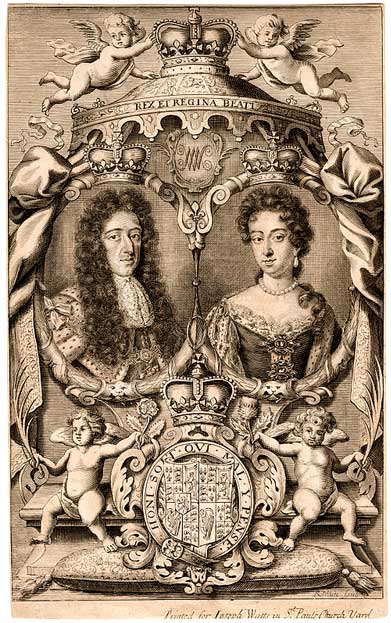
© National Portrait Gallery, London
1689
Ede's heritage
By the late seventeenth century the Shudalls had obtained royal patronage, receiving a commission as robemakers for the Coronation of William III and Mary II.
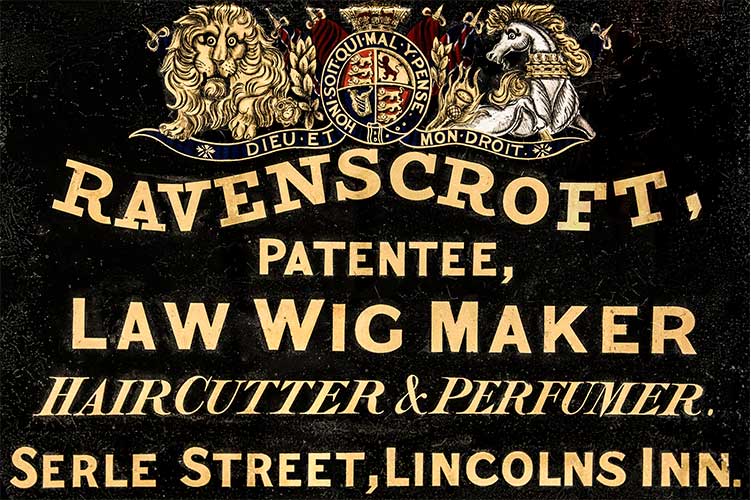
© E&R Archive and Collections
1726
Ravenscroft's heritage
In 1726 Thomas Ravenscroft founded a wigmaking business in Serle Street, Lincoln’s Inn.
Read More1726
Ravenscroft's heritage
The Ravenscroft wigmaking business was established by Thomas Ravenscroft in 1726 and operated independently until merging with the robemakers Ede & Son in 1902.
Although the wearing of wigs as a fashion accessory was on the wane by the late eighteenth century, Ravenscroft’s location, close to the Inns of Court in London, meant that the business was able to prosper by supplying wigs to the legal profession.

Ravenscroft shop sign, 19th century. © E&R Archive and Collections
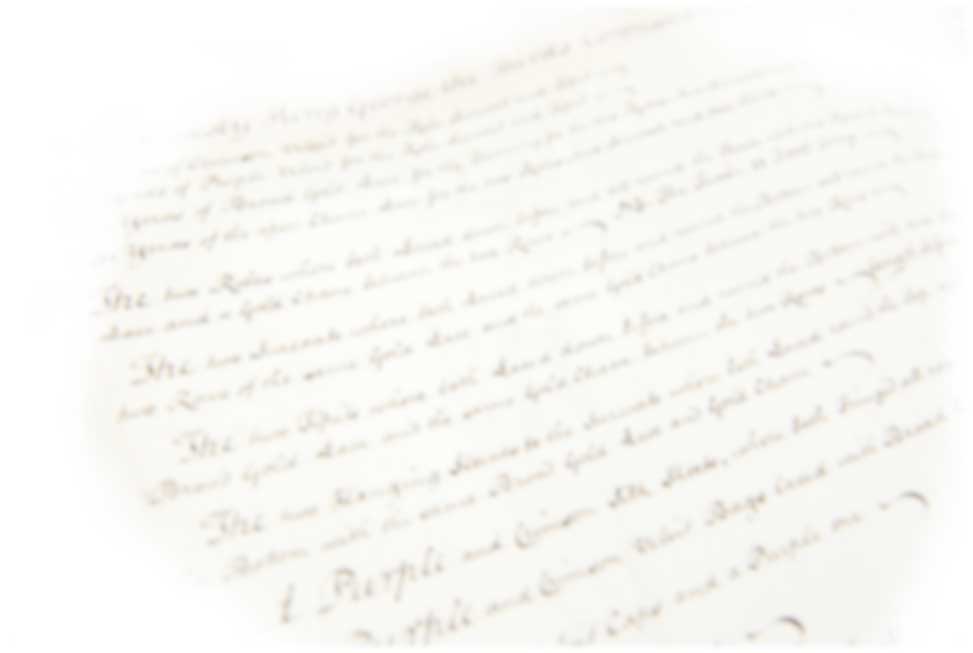
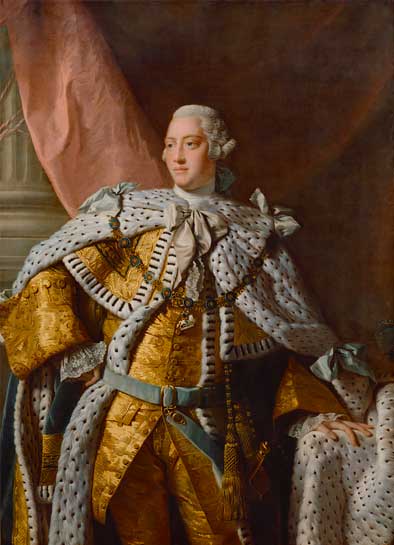
© National Portrait Gallery, London
1750s - 1760s
Ede's Heritage
The robemaking business continued to flourish throughout the eighteenth century, and in 1761 received an appointment to make the coronation robes for George III.
Read More1750s - 1760s
Ede's Heritage
Husband and wife, William and Martha Shudall were running the business by the mid eighteenth century. They maintained their reputation as specialist robemakers, with William regularly attending to the robing of the Order of the Garter ceremony at Windsor Castle. William died in 1757, and Martha continued the business in partnership with Francis Stone.
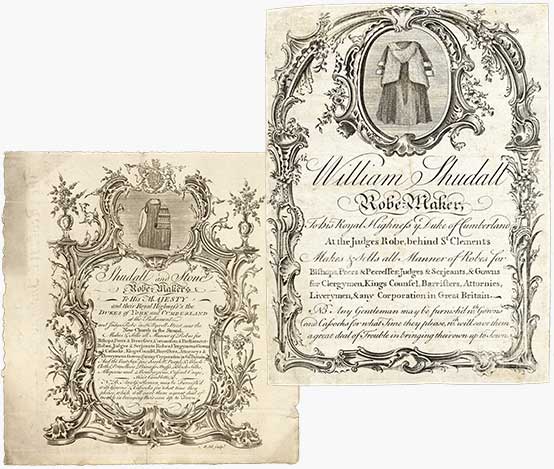
Trade Cards, William Shudall; Shudall and Stone, c1750-1760s.
© The Trustees of the British Museum
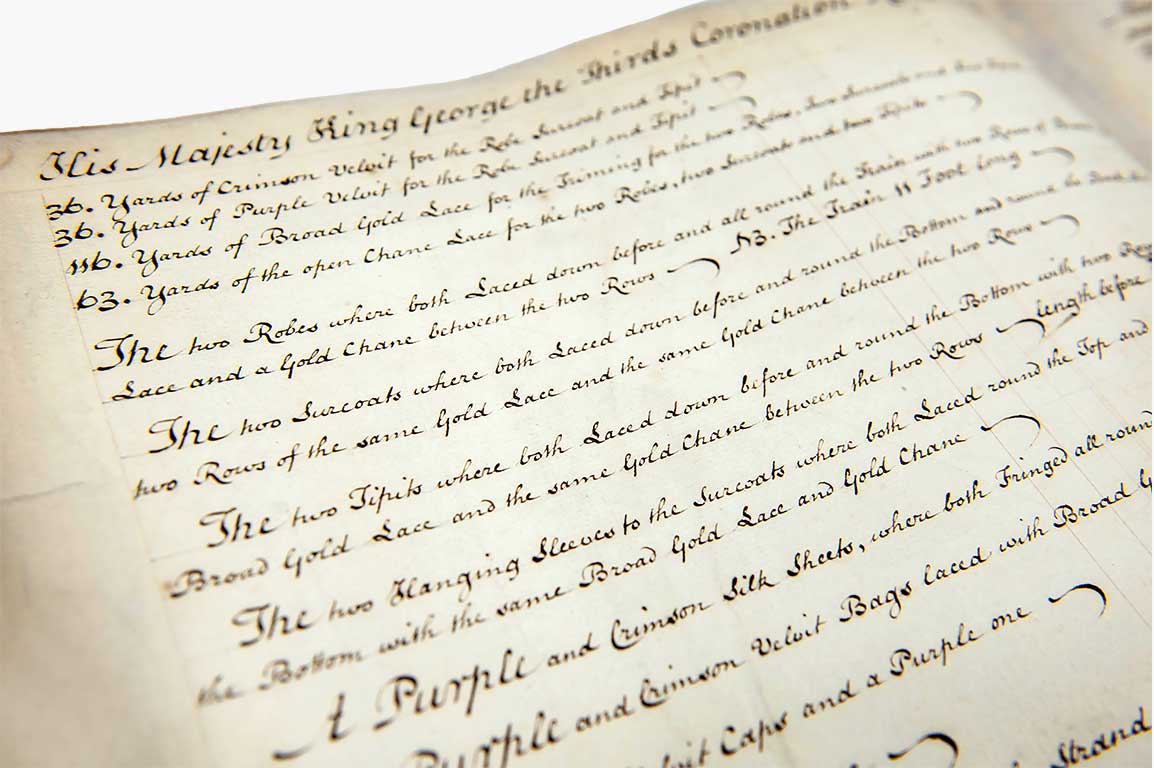
Ledger detailing specifications for George III's coronation robes, 1761.
© E&R Archive and Collections
During this period their largest appointment was to make the coronation robes for the Coronation of George III in 1761. The coronation robes are detailed in the company ledgers, and as well as the robes for the King and Queen Charlotte, the ledger also shows accounts for coronation robes for sixteen other dukes and 46 earls. Together with other degrees of peerage the total number of robes made for the coronation was well over a hundred.
1790s - 1810s
ede's heritage
William Webb inherited the robemaking business in 1797, after the death of his father-in-law Francis Stone. He continued to build on the success of his predecessors, receiving a royal warrant from George III as official robemaker.
Read More1790s - 1810s
Ede's Heritage
For over 200 years, the business has supplied officers of the College of Arms with ceremonial dress. The Kings of Arms, Heralds and Pursuivants are a distinctive sight on state occasions in their vividly coloured medieval-style tabards. Their dress indicates the long standing nature of their office as organisers of state ceremonial events and experts in armorial matters, having authority to grant new arms and confirm proven pedigrees and claims to existing arms.
In Scotland, the Lord Lyon King of Arms similarly oversees state ceremonial, with heraldic responsibility extending to the registering and recording of new clan tartans, upon the request of the clan chief.
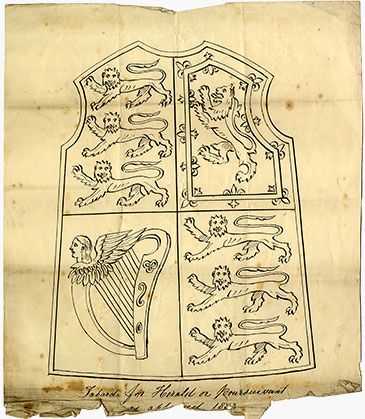
Tabard design approved by the College of Arms, 1883.
© E&R Archive and Collections
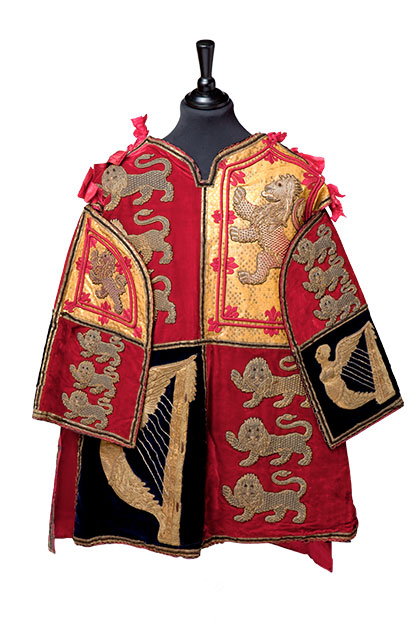
Lord Lyon King of Arms tabard, late 19th century, worn by Sir James Balfour-Paul during his tenure of office as Lord Lyon, 1890-1926. Sir James was on duty at the Coronations of Edward VII and George V, and at the state funerals of Queen Victoria and Edward VII. © E&R Archive and Collections
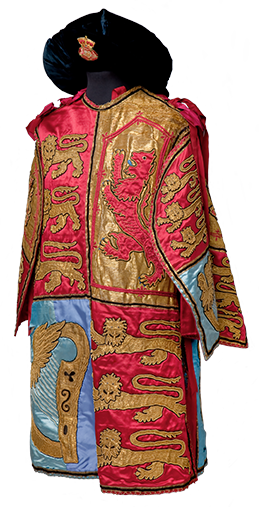
Herald’s tabard, early 20th century.
© E&R Archive and Collections
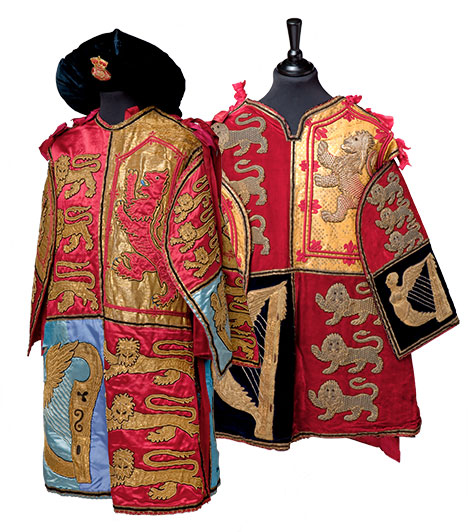
© E&R Archive and Collections
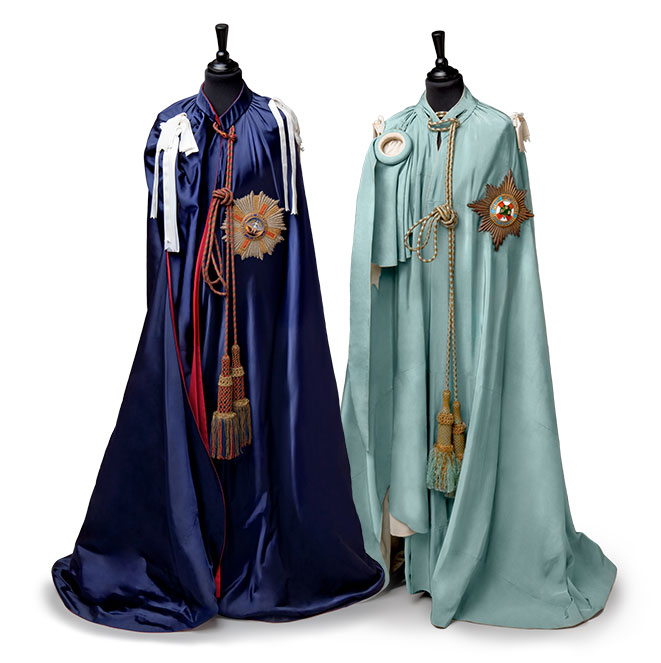
© E&R Archive and Collections
1790s - 1810s
ede's heritage
William Webb continued the business of supplying chivalric robes, a tradition which Ede & Ravenscroft maintains to this day.
Read More1790s - 1810s
Ede's Heritage
During this period, both George III and IV embraced the revival of the medieval Chivalric Orders, enlarging the membership of traditional Orders and establishing the (now dormant) Order of St Patrick in 1783 and the Order of St Michael and St George in 1818, with further Orders created by successive monarchs during the nineteenth and twentieth centuries.
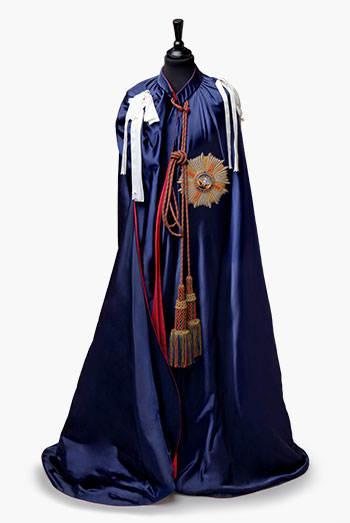
Order of St Michael and St George mantle, early C20th
© E&R Archive and Collections
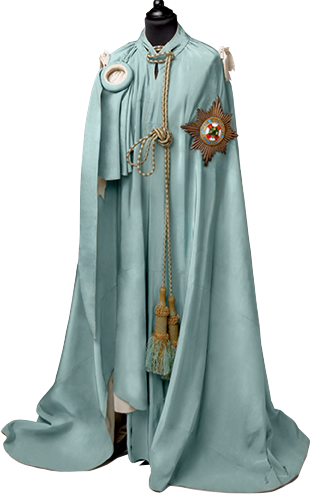
Order of St Patrick mantle, early 20th century.
© E&R Archive and Collections
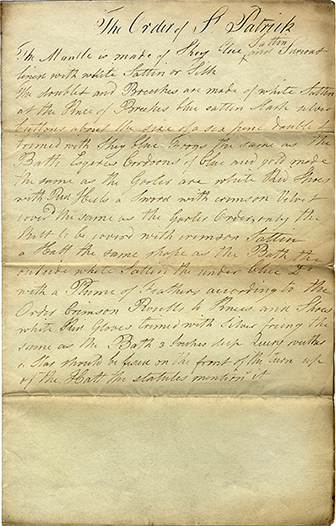
William Webb’s making instructions for the Order of St Patrick sky blue mantle, 1809.
© E&R Archive and Collections
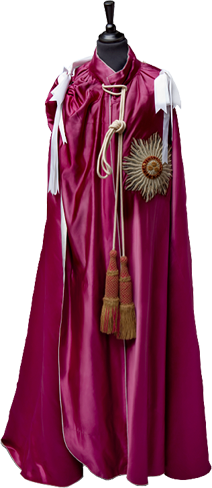
Order of the Bath Knight Grand Cross (GCB) mantle, early 20th cent.
© E&R Archive and Collections
The Order of the Bath has its origins in the ritual bathing which took place before the honour of knighthood was conferred, documented from the 12th century. However, the Most Honourable Military Order of the Bath was established as a specifically military Order in 1725 and restructured into differing classes in 1815 by the Prince Regent. This was as a direct consequence of the Napoleonic Wars from which arose the need to reward distinguished military and naval service in large numbers.
Admiral Horatio Nelson, as Commodore Nelson, was appointed a Knight of the Bath by George III in 1797 for outstanding service in the Battle of Cape St Vincent. His installation to the Order was to have taken place on 19th May 1803 in a service in Westminster Abbey, but his knighthood was received by proxy due to war resuming against Napoleonic France the day before the ceremony . This letter of January 1803 requesting an Order of the Bath mantle be delivered to William Webb, was written during the brief period of peace between 1802 and 1803 when Nelson enjoyed his final extended period of civilian life.
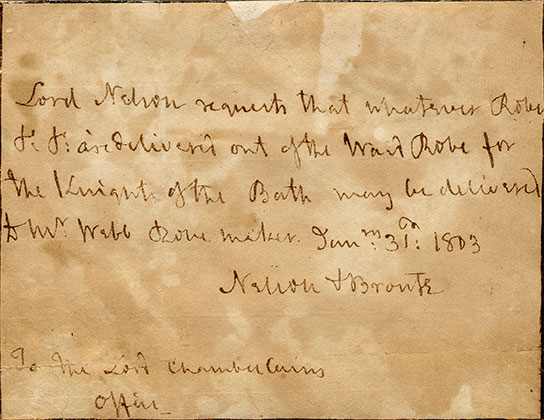
Letter from Lord Nelson requesting an Order of the Bath mantle be delivered to
Mr Webb, robemaker, 1803.
© E&R Archive and Collections
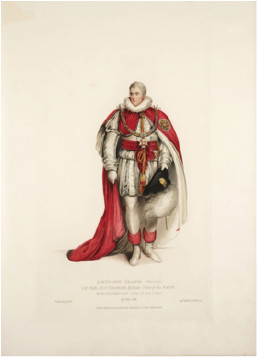
Knight Grand Cross of the Order of the Bath, at the Coronation of George IV,
1821. © E&R Archive and Collections
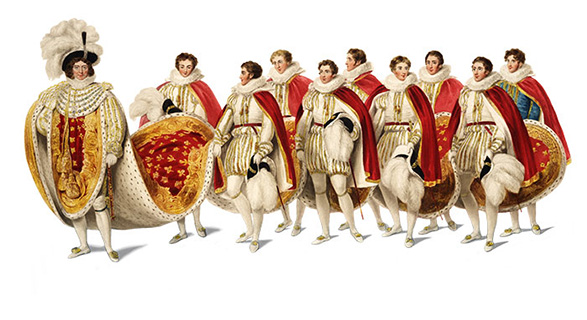
© E&R Archive and Collections
1820s
ede's heritage
William Webb obtained a royal warrant from George IV early in the King's reign, in 1820, and was then appointed to work as robemaker for the lavish Coronation in 1821.
Read More1820s
Ede's Heritage
William Webb became a key figure in creating the King’s vision of using chivalric pageantry for the event, and was requested to provide hundreds of mantles for knights and officers of the Orders of Chivalry. The business also supplied peers’ coronation robes, including the dress worn by the eight eldest sons of peers’ in attendance to the King.
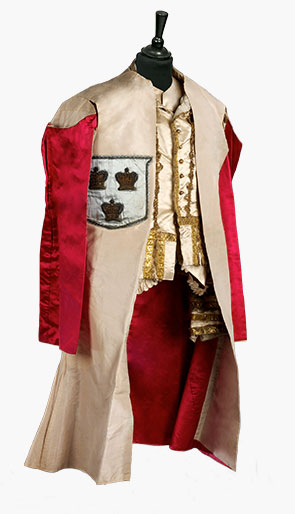
Esquire’s dress for the Order of the Bath,
c1821, Wm Webb. © E&R Archive and Collections
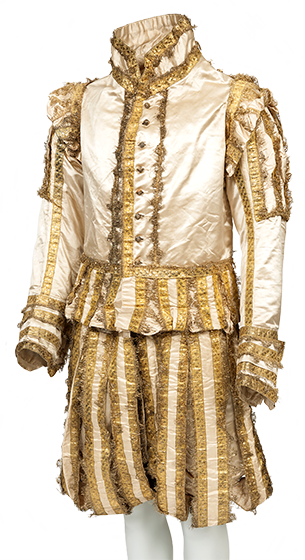
Sons of peers’ coronation underdress for Coronation of George
IV, 1821, Wm Webb. © E&R Archive and Collections
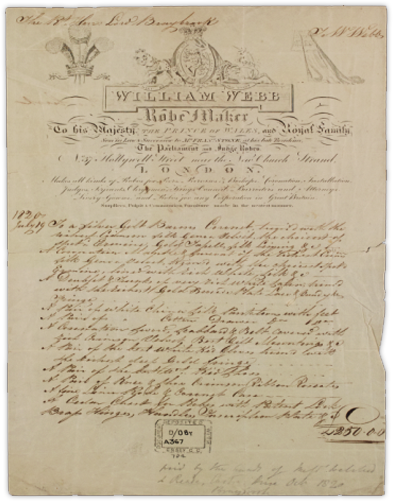
Invoice to Lord Braybrook, Jun 1820, detailing purchases
made for coronation dress. © Essex Record Office
Peers’ robes for George IV’s Coronation were required to be worn over sumptuous sixteenth century style underdress, including doublets and trunk hose. William Webb’s invoice to Lord Braybrooke details the complete outfit which included not only the coronation mantle and coronet, but also a doublet and trunk ‘of very rich white satin trim’d with the richest gold beaded plate lace and vandyked fringe’, silk pantaloons, kid gloves and shoes and a pair of knee and shoe crimson ribbon rosettes. Also required was a surcoat, a velvet undercoat which had fallen into disuse, revived for the 1821 coronation and obsolete again for subsequent coronations. The less extravagant coronations of the 1830s saw a return to peers wearing robes over court dress or uniform.
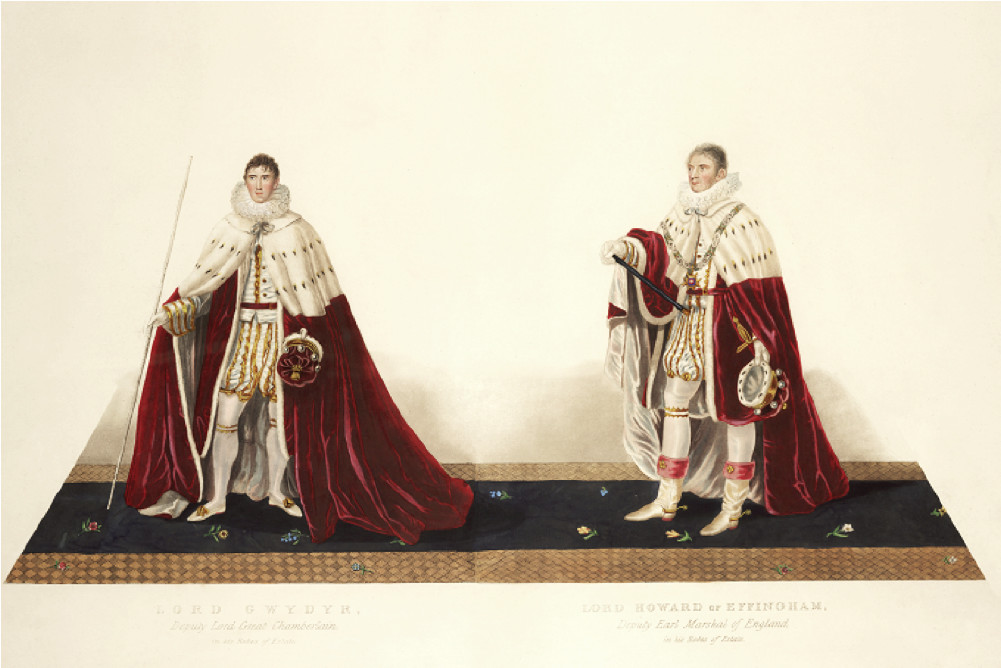
Lord Gwydyr and Lord Howard of Effingham in Baron’s coronation robe and underdress, 1821. © E&R Archive and Collections
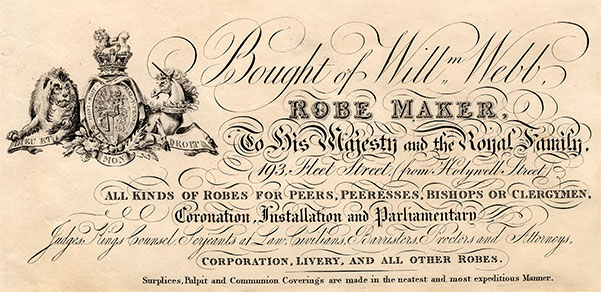
© E&R Archive and Collections
In 1827 William Webb acquired new premises at 193 Fleet Street, the first move away from Holywell Street since the establishment of the business in the seventeenth century.
1820s
Ravenscroft's heritage
The Ravenscroft wigmaking business continued to thrive during the nineteenth century, due in part to the invention by Humphrey Ravenscroft of the patent forensic wig.
Read More1820
Ravenscroft's heritage
Humphrey Ravenscroft (grandson of the founder Thomas Ravenscroft) pioneered the so-called forensic wig in 1822 for which he devised a method of permanently setting wig curls into place. This finally dispensed with the inconvenience of maintaining a wig which had previously involved daily frizzing and curling the horsehair and treating with a thick scented ointment and powder. Ravenscroft’s innovation was an immediate success.
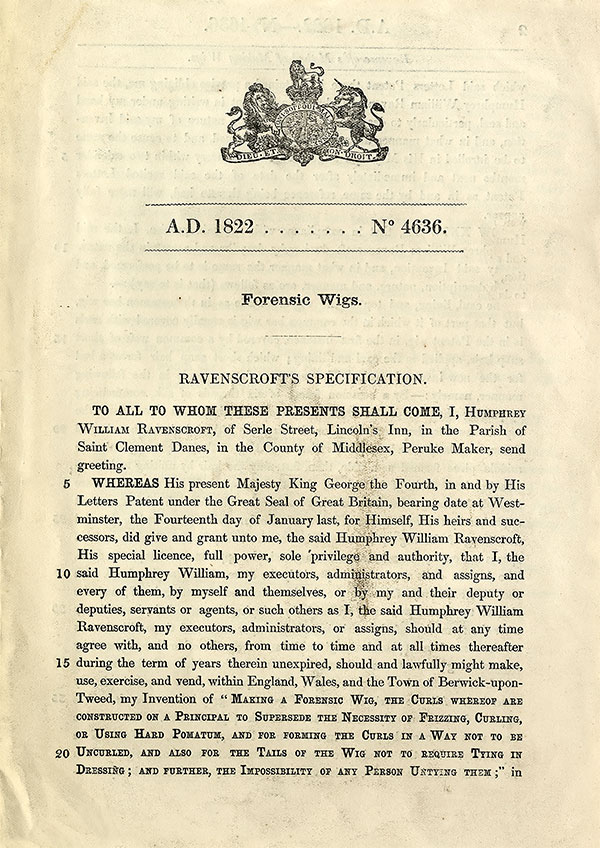
Ravenscroft’s forensic wig patent, 1822.
© E&R Archive and Collections
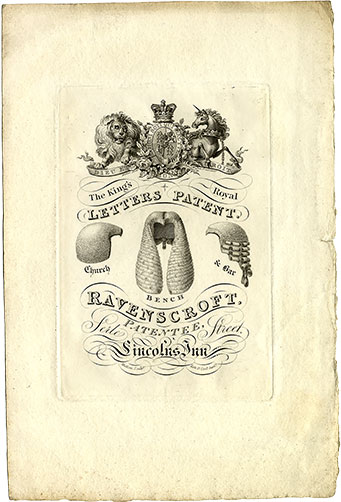
© E&R Archive and Collections
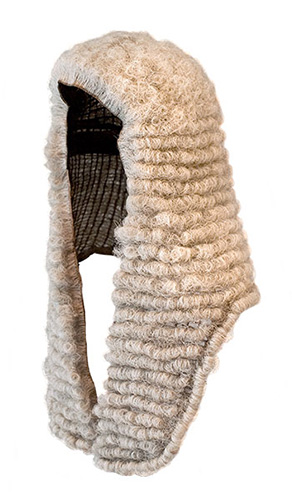
Lord Denning’s wig, late 20th century.
© E&R Archive and Collections
1830s
Ravenscroft's heritage
Following the success of his barrister’s wig, Humphrey Ravenscroft went on to develop an equivalent full-bottomed judge’s wig in 1835.
Ravenscroft’s advertisement for the new wig declared his new design to be ‘the highest state of perfection’, being ‘remodelled and executed on an entirely new principle’.
Read More1830
Ravenscroft's heritage
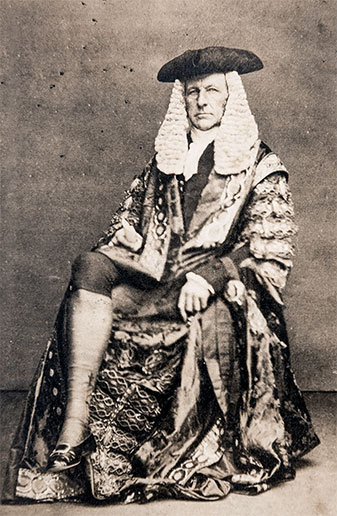
Speaker of the House of Commons, 1861, Rt Hon J E Denison, wearing full-bottomed wig. From a series of legal portraits collated by Burton Ravenscroft during the mid-19th century.
© E&R Archive and Collections
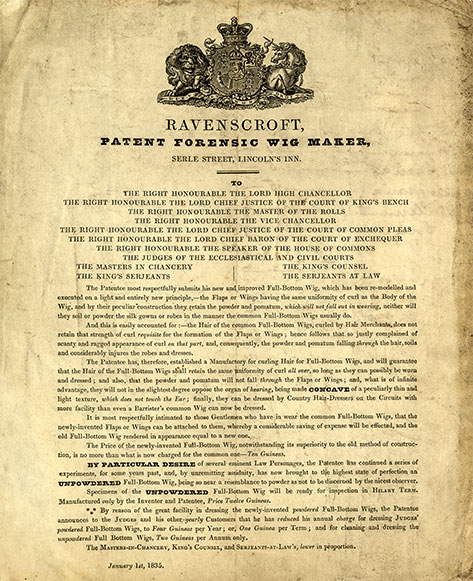
Ravenscroft advertisement for the patent forensic full-bottomed wig, 1835.
© E&R Archive and Collections
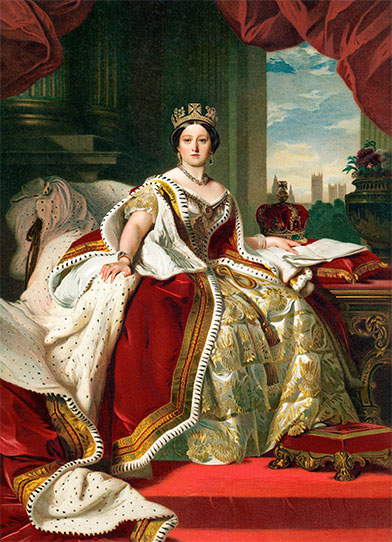
© Lordprice Collection/Alamy Stock Photo
1830s - 1850s
Ede's heritage
William Webb’s apprentice, Joseph Ede, acquired the business in 1834 with his uncle Thomas Adams. They upheld the robemaker’s unbroken record as royal warrant holders, successively obtaining William IV’s warrant in their first year of trading, and Queen Victoria’s in the first year of her reign in 1837.
Read More1830s - 1850s
Ede's Heritage
William Webb died in 1831 and the business passed to his son Frederick, assisted by Joseph Ede, an apprentice who had been taken on in 1811.
In 1834 Webb’s business was acquired by Thomas Adams, Joseph Ede’s uncle, and began trading as Adams & Ede.
Joseph Ede eventually took over and the firm took the name ‘Joseph Ede’ in 1848. He received a series of warrants from Queen Victoria, the business continuing to expand and prosper throughout the nineteenth century.
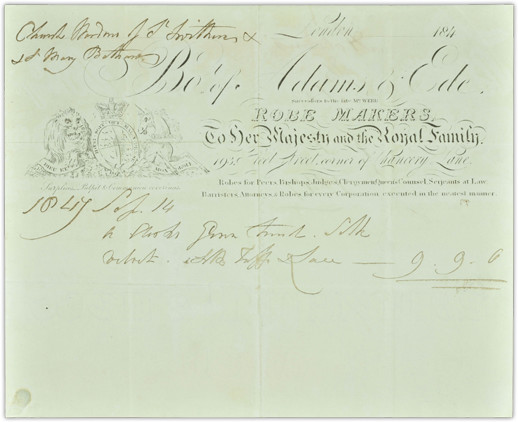
Adams & Ede invoice to the churchwardens of St Swithins with St Mary
Bothaw, 1847. © London Metropolitan Archives
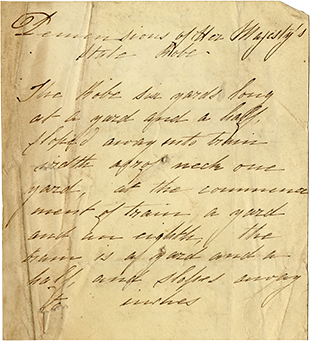
Dimensions of Her Majesty’s State Robes, 1879 (taken from 1838 ledger).
© E&R Archive and Collections
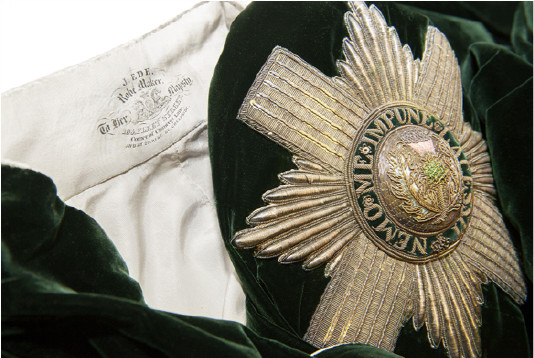
Thistle mantle, c1850s. © E&R Archive and Collections
The Most Ancient and Most Noble Order of the Thistle is a Scottish Order of Chivalry revived during the seventeenth century from an Order with ancient foundations, and has remained an exclusively Scottish honour.
Continued royal support for the Order during the nineteenth century was ensured by Queen Victoria’s regular residence in Scotland. Her first visit to Scotland with Prince Albert was in 1842. In the same year, Adams and Ede was appointed to make Prince Albert’s Order of the Thistle mantle, the Order to which he was appointed in 1843 as the first ‘Extra Knight’ created by special statute for members of the royal family and foreign monarchs.
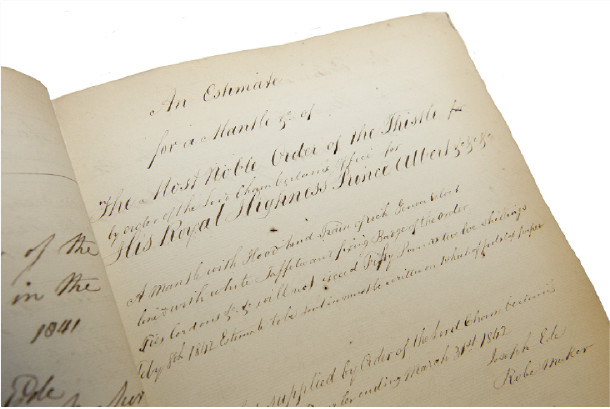
Joseph Ede’s estimate for Prince Albert’s Thistle mantle, 1842. © E&R Archive and Collections
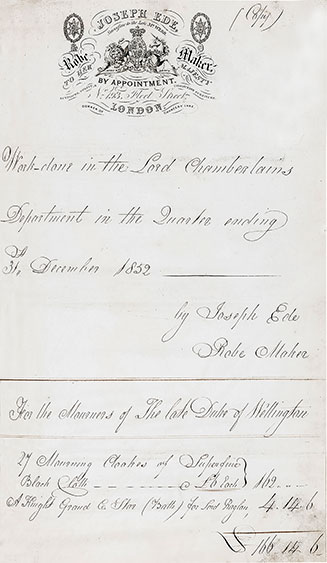
Estimate for mourning cloaks for mourners of the Duke of Wellington, 1852.
© E&R Archive and Collections
Between the mid- to late-nineteenth century, strict adherence to the rituals and customs of mourning, particularly in dress, reached its height. Consequently, the correct fulfilment of mourning dress etiquette became an important part of the tailoring industry. During this period, Joseph Ede’s ledgers include hundreds of orders for mourning bands and ‘weepers’, cuffs of ruffled white lace worn over the sleeves, worn at court during periods of national mourning.
Day Book, 21 Jun 1837. Orders for mourning bands and weepers worn at court after the death of William IV.
© E&R Archive and Collections
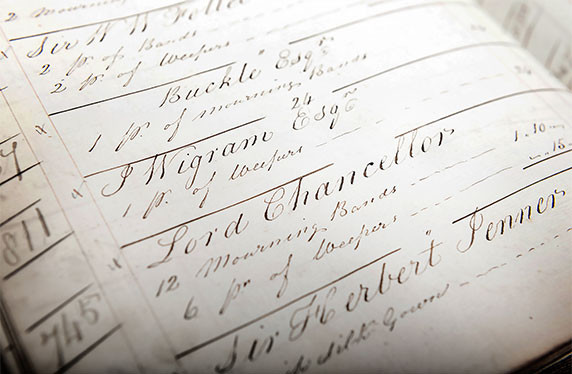
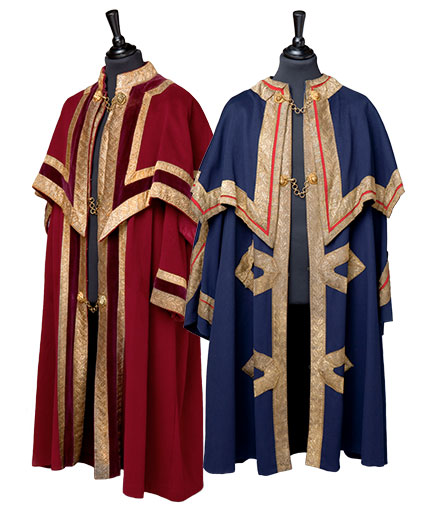
© E&R Archive and Collections
1830s - 1850s
Ede's heritage
The 1835 Municipal Corporations Act established many new mayoralties throughout Britain and led to an increase in demand for new civic robes.
Read More1830s - 1850s
Ede's Heritage
Ede & Ravenscroft has long been robemakers to the Corporation of London, making robes for the City livery companies, the Lord Mayor and officials. Demand for civic robes rose substantially during the nineteenth century after the 1835 Municipal Corporations Act which established a system of municipal boroughs throughout the country, governed by town councillors requiring civic robes. The business was subsequently required to supply robes for the officials of 390 boroughs across the country, and 28 London boroughs.
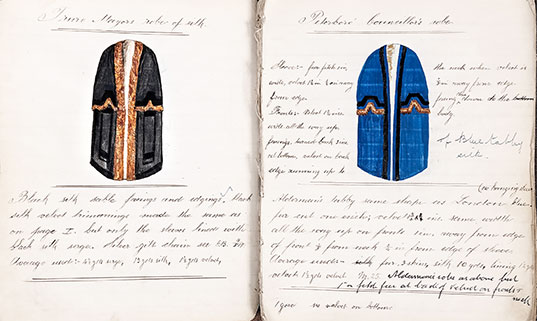
Design specifications for civic robes, late 19th century.
© E&R Archive and Collections
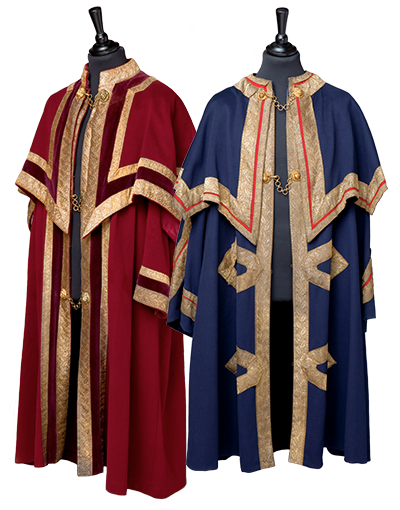
Ward Beadle’s cape coats, City of London, early 20th century.
© E&R Archive and Collections
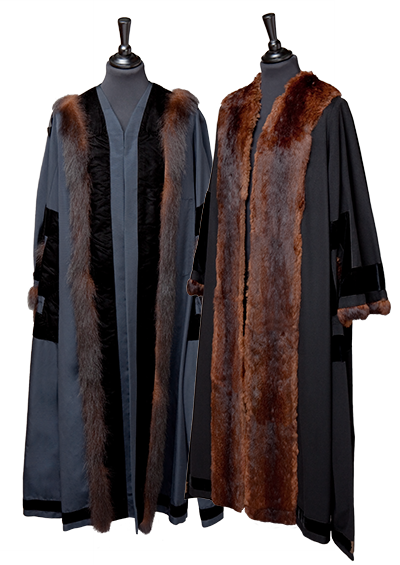
City of London Alderman’s robe, mid 19th century; City of London Master/Warden’s livery robe, early 20th century. © E&R Archive and Collections

© E&R Archive and Collections
1860s
Ede's heritage
Joseph Ede’s son Joseph inherited the business and, trading as Ede & Son, relocated to 93/94 Chancery Lane in 1868.
Read More1860s
Ede's Heritage
Joseph died in 1862 and his widow Anne took over the business for a short time. By 1868 their son Joseph Webb Ede had taken over (his middle name ‘Webb’ given in memory of his father’s former employer William Webb), renaming the firm ‘Ede & Son’.
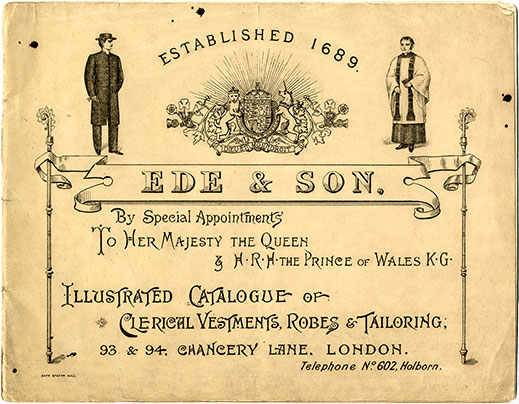
Ede & Son catalogue, 1896.
© E&R Archive and Collections
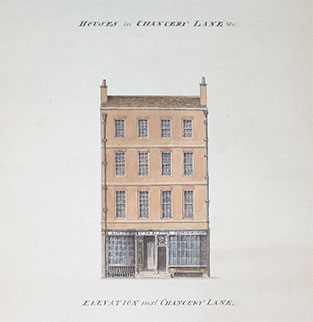
Elevation of 94 Chancery Lane, 1814.
© Magdalen College, Oxford
In 1868 Ede & Son relocated to nos 93-94 Chancery Lane which is where the company head office is still located. This proved to be a well-chosen location situated close to the Inns of Court, legal dress being then, as now, an important part of the business, supplying the full range of legal clothing from plain back barrister’s robes through to the highly embellished black and gold robes of the senior judiciary. Up to 1933, the business supplied all judges on appointment with a definitive guide to dress regulations entitled the ‘Judges’ Robing List’.
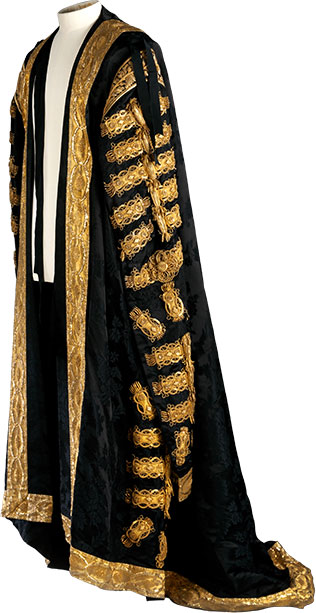
The Master of the Rolls state robe, c1910, Ede, Son and Ravenscroft.
© E&R Archive and Collections
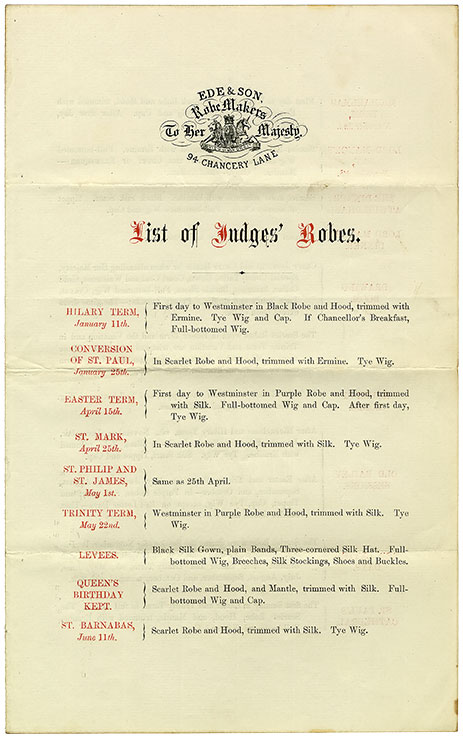
Ede & Son Judges’ Robing List, late 19th century.
© E&R Archive and Collections
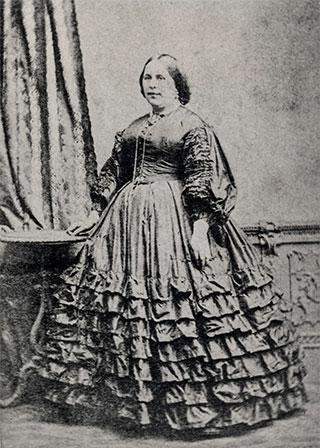
Rosa Ede (née Ravenscroft), c1890s.
© E&R Archive and Collections
1870s - 1890s
Ede's heritage
In 1871 Joseph Webb Ede of the robemaking business Ede & Son married Rosanna Ravenscroft (Rosa Ede), daughter of Burton Ravenscroft of the wigmaking Ravenscroft business, beginning an association of the two local, complementary trades.
Read More1870s - 1890s
Ede's Heritage
The marriage between Joseph Webb Ede and Rosanna Ravenscroft was a significant event, uniting the two trades, although a formal merger was a number of years later, in 1902.
However, Joseph died six months into the marriage, at the age of 26, leaving his widow Rosa Ede to take over the robemaking business. Queen Victoria confirmed the appointment of Rosa Ede as her new robemaker in September 1871, and Rosa went on to manage the business for sixty years.
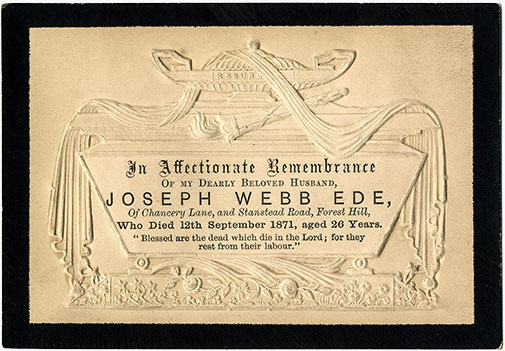
Memorial card, Joseph Webb Ede, 1871.
© E&R Archive and Collections
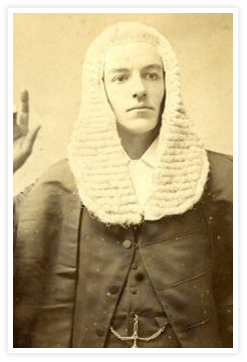
Hugh Enes Blackmore as Sir Bailey Barre QC in the premiere of Gilbert and Sullivan’s Utopia Ltd in 1893, wearing costume provided by both Ede & Son, and Ravenscroft wigmakers.
Wikimedia Commons/Public Domain
https://commons.wikimedia.org/wiki/File:Hughenesblackmore.jpg
The company has long provided costume for theatre, television and film. As early as the 1890s, garments were provided for original productions of the D’Oyly Carte Opera Company’s Iolanthe and Utopia Limited at the Savoy Theatre, to W S Gilbert’s own specifications.
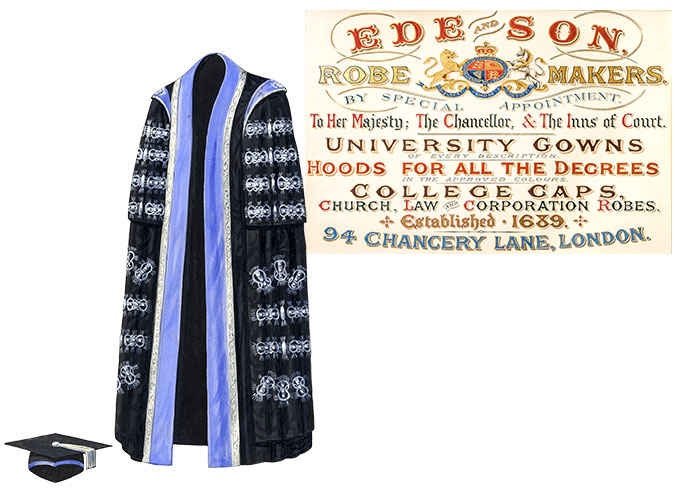
© E&R Archive and Collections
1870s - 1890s
Ede's heritage
By the 1870s Ede & Son was supplying academic dress to more than twenty universities throughout Britain.
Read More1870s - 1890s
Ede's Heritage
The business supplied academic dress to the universities of Oxford and Cambridge from its inception, but this trade gradually expanded over the course of the nineteenth and early twentieth centuries when a number of new universities, such as the University of London, were founded.
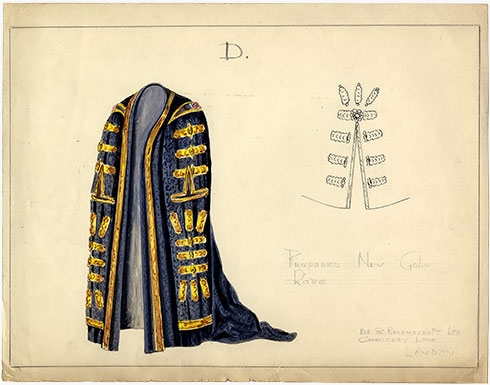
Design for University of London, Chancellor’s robe, 1955.
© E&R Archive and Collections
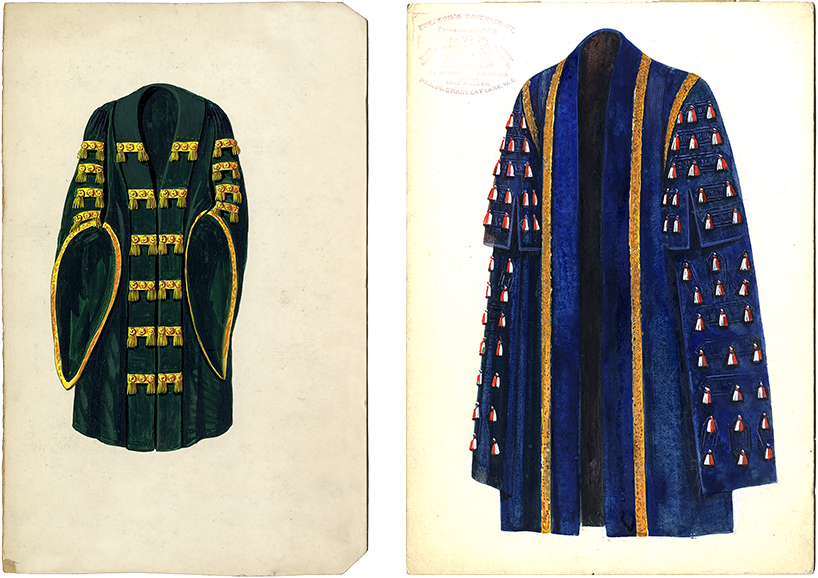
Academic dress designs, early 20th century.
© E&R Archive and Collections
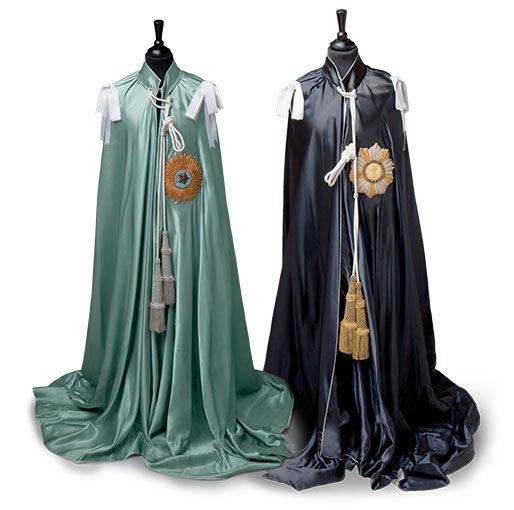
© E&R Archive and Collections
1870s - 1890s
Ede's heritage
Queen Victoria instituted two new Orders of Chivalry during the late nineteenth century, both of which were associated with the Indian Empire.
Read More1870s - 1890s
Ede's Heritage
The Most Exalted Order of the Star of India was founded in 1861, its insignia (badge and star) being the most costly of any Order of Chivalry at the time of their introduction, being set with diamonds. In 1886, the Most Eminent Order of the Indian Empire was founded, its mantle a deep blue silk lined with white.
Many of the Indian princes and maharajas were appointed to these Orders which were also open to British subjects who had rendered valuable service to the Empire in India.
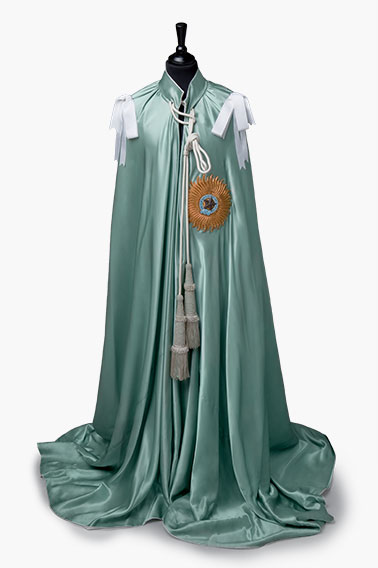
The Most Exalted Order of the Star of India, Knight Grand Commander, (GCSI); mantle with badge and cordons.
© E&R Archive and Collections
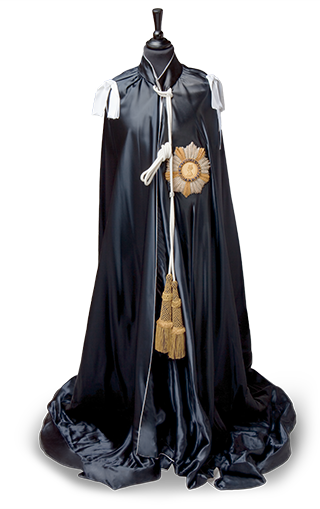
The Most Eminent Order of the Indian Empire, Knight Grand Commander, (GCIE); mantle with badge and cordons.
© E&R Archive and Collections
Correspondence confirming Ede & Son as robemakers to Sir Bhagwat Singhji, 1897.
© E&R Archive and Collections
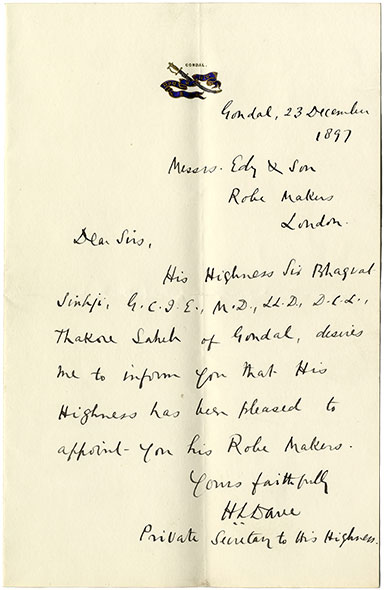
H.H Maharaja Thakore Shri Sir Bhagwat Singhji Sagramji Sahib Bahadur, Maharaja of Gondal GCSI, GCIE (then a GCIE), wearing robes of the Knight Grand Commander of the Order of the Indian Empire during his visit to London for the Coronation of King George V in 1911. © Victoria and Albert Museum, London
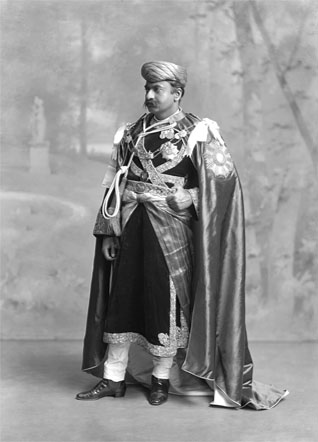
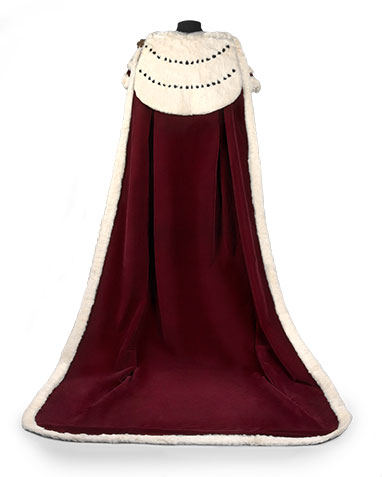
© E&R Archive and Collections
1900s
Ede & Ravenscroft's heritage
1902 saw the official merger of the robe and wig making firms, becoming Ede, Son & Ravenscroft, and the Coronation of Edward VII, for which the business was required to undertake considerable work.
Read More1900s
Ede & Ravenscroft's Heritage
Ede, Son & Ravenscroft was responsible for a large proportion of the robemaking for the Coronation of Edward VII, the requirements for which were considerable due to there not having been a coronation since 1838. Entries in the company ledgers list the extensive work required for Edward VII and Queen Alexandra’s robes, as well as robes for peers, officers of state, bishops and clergy. The company was also commissioned to supply altar cloths and velvet to upholster the coronation chairs.
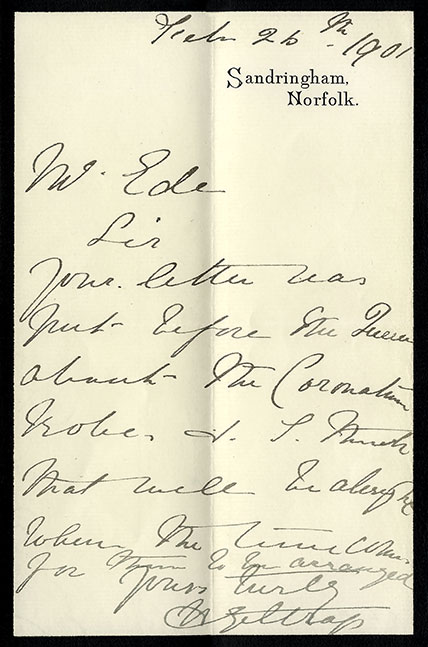
Letter from Harriet Giltrap, dresser to Queen Alexandra, confirming Ede & Son to supply the Queen’s coronation robes, 1901. © E&R Archive and Collections
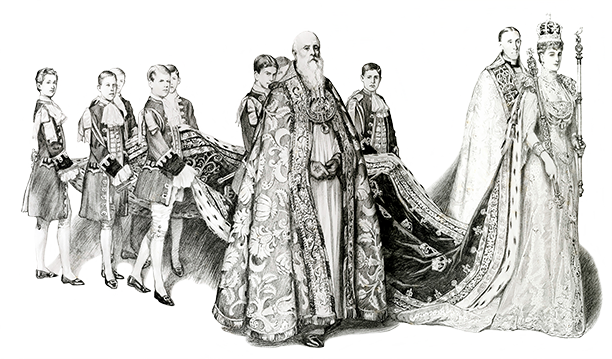
Queen Alexandra in coronation robes, 1902.
© E&R Archive and Collections
In 1902 the two companies officially merged: Ede & Son, robemakers, with Ravenscroft, wigmakers. Burton Ravenscroft, Rosa’s eldest brother, had taken over the wigmaking business in Serle Street, and he now moved it to premises at 1 Star Yard, backing onto Ede & Son’s Chancery Lane shop. With the merger came a change of name, to Ede, Son & Ravenscroft.
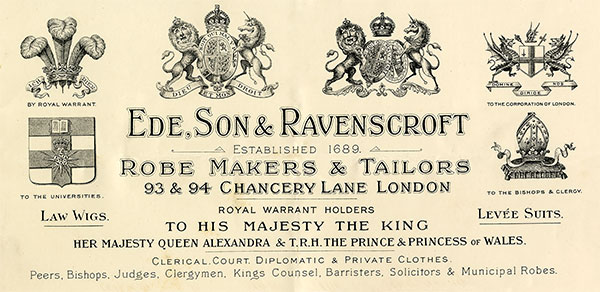
© E&R Archive and Collections
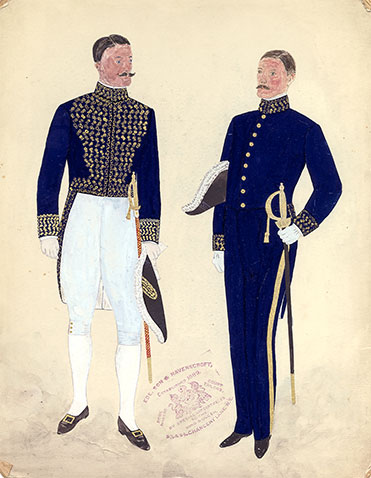
© E&R Archive and Collections
1900s
Ede & Ravenscroft's heritage
Between the mid nineteenth and early twentieth centuries the wearing of court dress while in attendance at the royal court, and diplomatic uniforms for diplomats and consuls, reached its height.
Read More1900s
Ede & Ravenscroft's Heritage
Ede & Ravenscroft has long provided and continue to supply court dress, worn today by the Queen’s Counsel and some judges, and the Serjeant and Assistant Serjeant at Arms of Parliament, and select officials on formal state occasions.
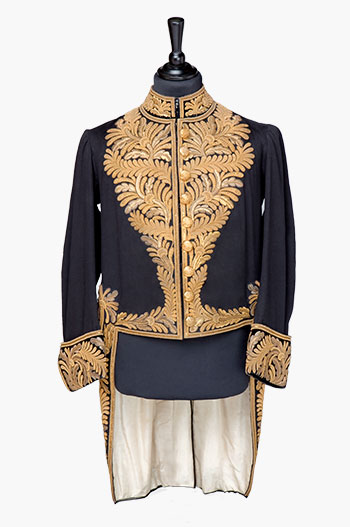
Privy Councillor’s full dress uniform, 1st Class, early 20th century.
© E&R Archive and Collections
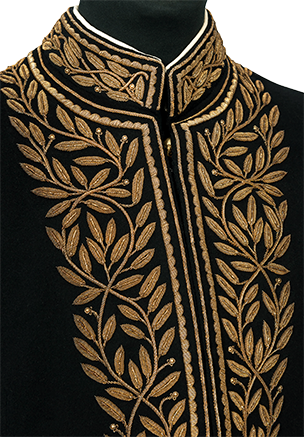
Greek Diplomatic uniform, early 20th century.
© E&R Archive and Collections
During the nineteenth century, diplomatic uniforms were introduced for diplomats and consuls to wear on public occasions. Based on court dress, diplomatic dress was similarly abandoned by most countries during the twentieth century. Although it began as a European style dress, many non-European states also adopted the uniform. As well as providing many European countries with diplomatic uniform, Ede, Son & Ravenscroft made dress for the diplomatic and consular services of countries such as Argentina, China, Ecuador, Panama, Persia and Venezuela.
Diplomatic dress followed nineteenth century court fashion, and was richly decorated with gold embroidery indicating rank and particular to each country; for example, the Norwegian diplomatic uniform incorporated a pine cone embroidery design, the Greek diplomatic uniform an olive leaf design.
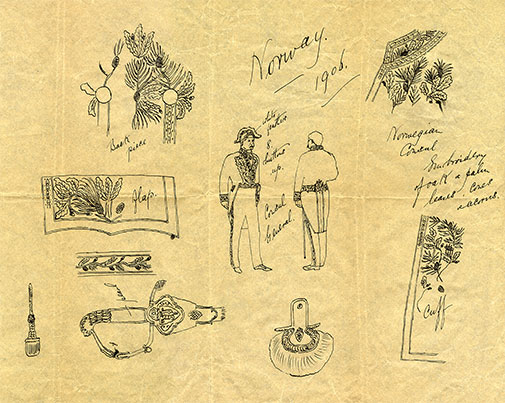
Designs for Norwegian Consul-General uniform, 1906.
© E&R Archive and Collections
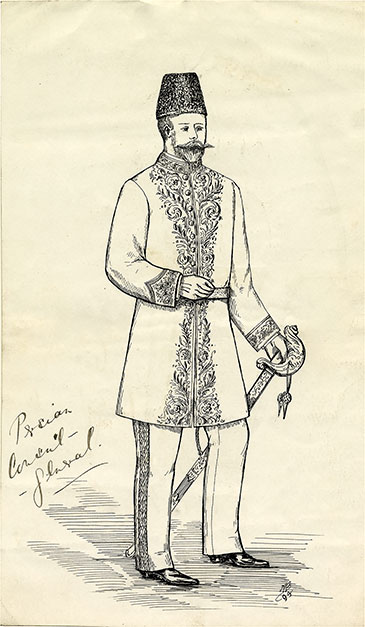
Persian Consul-General illustration, early 20th century.
© E&R Archive and Collections
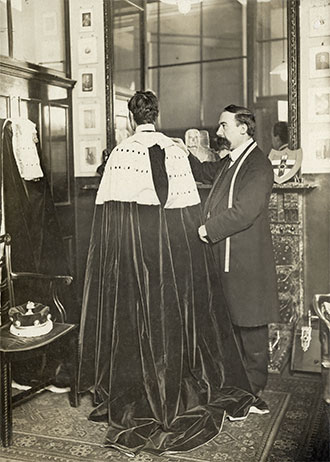
© E&R Archive and Collections
1910s
Ede & Ravenscroft's heritage
The Coronation of George V in 1911 required Ede, Son and Ravenscroft to make adjustments to existing robes used for the previous coronation ceremony, nine years earlier.
Read More1910s
Ede & Ravenscroft's Heritage
With another Coronation only nine years since the previous ceremony, there was little new robemaking to be done for this event. Ede, Son and Ravenscroft was required to make adjustments to existing robes, and even the robes worn by Edward VII and Queen Alexandra at the previous Coronation were adapted by the company to be worn by George V and Queen Mary.
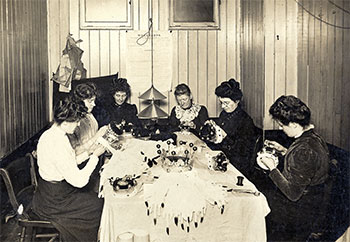
Ede, Son and Ravenscroft employees preparing for the 1911 Coronation.
© E&R Archive and Collections
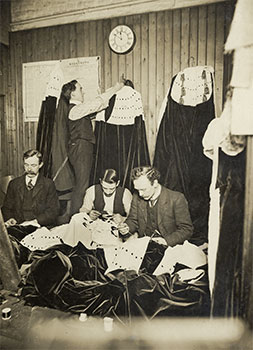
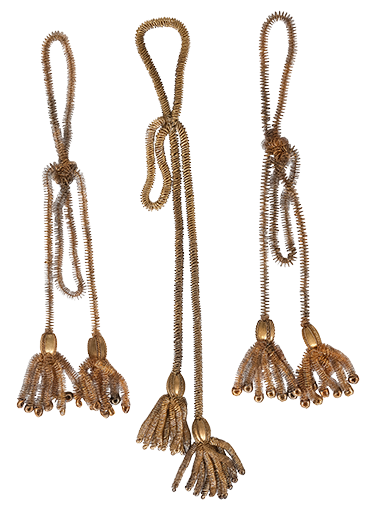
Tassels for Queen Mary’s Coronation robes, 1911.
© E&R Archive and Collections
As robemakers to the Prince of Wales (later Edward VIII), the company made the Order of the Garter robes he wore at the Coronation of George V in June 1911, and the velvet robes for his investiture at Caernarvon in July of the same year.

Prince Edward of Wales with Princess Mary, the Princess Royal, at the Coronation of their parents, 1911.
© E&R Archive and Collections
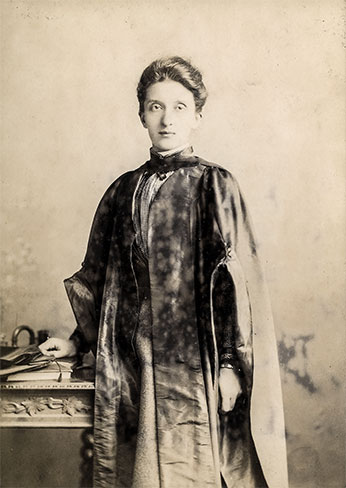
© E&R Archive and Collections
1910s
Ede & Ravenscroft's heritage
The rise of the women’s emancipation movement in Britain required Ede, Son and Ravenscroft to provide academic and ceremonial robes to a wider female clientele.
Read More1910s
Ede & Ravenscroft's Heritage
With a woman at the helm for the previous forty years the provision of female academic dress was a task the business embraced, providing graduate robes for the Women’s Suffrage Procession in 1911.
The 1911 Women’s Coronation Procession was the largest demonstration up to that time in support of British women’s suffrage. Forty thousand women participated in the march in London, in which the processing of graduate suffragists in their academic hoods and robes was an important visual and symbolic act.
Written the day before the procession took place and a week before the Coronation itself, this letter details arrangements for the hire of academic gowns from Ede, Son and Ravenscroft by the London Graduates’ Union for Women’s Suffrage, thanking the company for coming to their assistance.
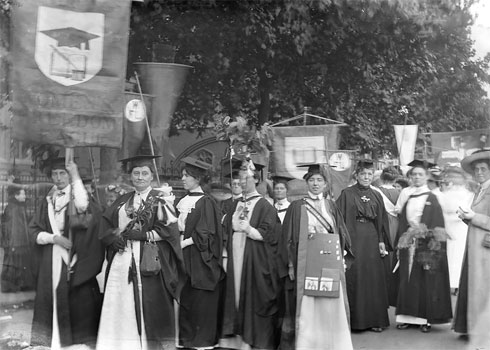
Suffragists in academic robes, Coronation Procession, 1911.
© Museum of London
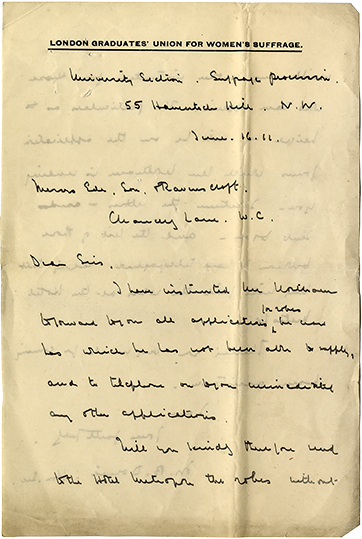
© E&R Archive and Collections
The admission of women into the male chivalric orders began in 1917, with the introduction of the Order of the British Empire, the title of Dame becoming an official equivalent of Knight. This was subsequently extended to other orders, the Royal Victorian Order first admitting women in 1936, the Order of St Michael and St John in 1965, and the Order of the Bath in 1971. In 1987 women were first eligible to be installed into the Orders of the Garter and Thistle as Ladies Companion, on equal terms with their male counterparts.
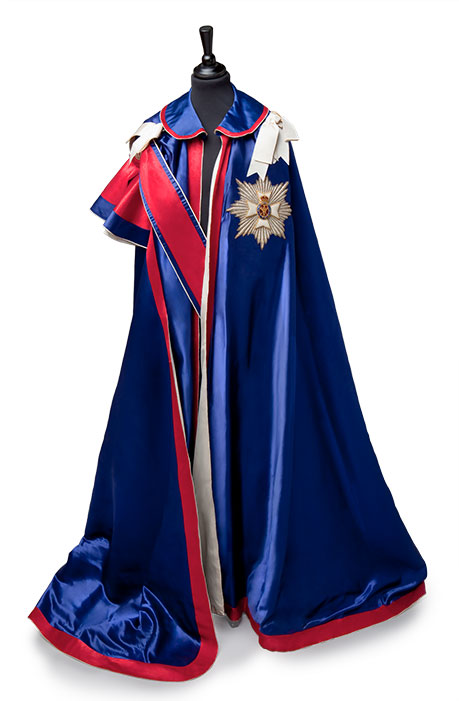
Royal Victorian Order, Dame Grand Cross, ladies’ mantle. Formerly belonging to Helen Percy, Duchess of Northumberland, c1938.
© E&R Archive and Collections
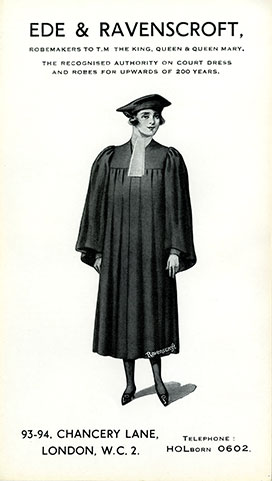
© E&R Archive and Collections
1920s
Ede & Ravenscroft's heritage
In 1921 the business was officially renamed Ede & Ravenscroft.
Read More1920s
Ede & Ravenscroft's Heritage
At the beginning of the twentieth century, all female academic robes were a distinct ankle length design in order to cover a full skirt length. As hemlines rose during the 1920s, so too could female academic dress, and by the 1930s academic robes had become a largely unisex style.
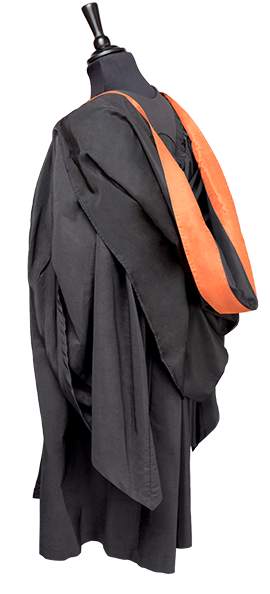
Gown and hood purchased by Miss F A Taylor for award of a Bachelor of Commerce degree (now obsolete in the UK) from the University of London, 1928, with invoice © E&R Archive and Collections
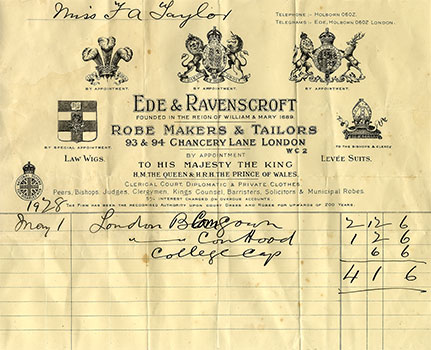
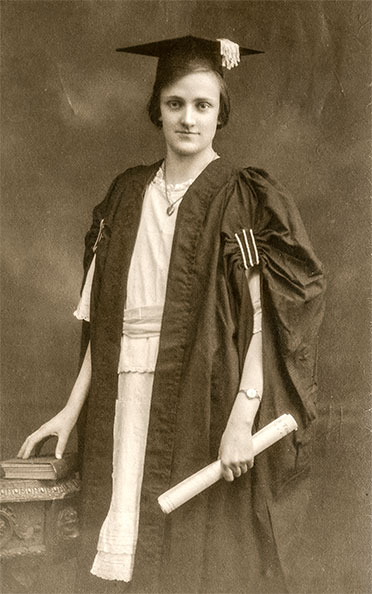
Lancaster College of Music graduate, c1920s.
© E&R Archive and Collections
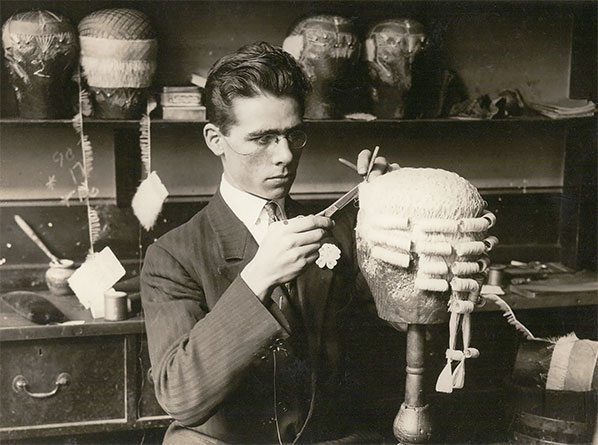
© Private Collection
1920s
Ede & Ravenscroft's heritage
Throughout the early decades of the twentieth century, Rosa Ede continued to run the robemaking side of the business with her brothers Clement and Vernon Ravenscroft, while her brothers Burton and Ernest Ravenscroft managed the wigmaking.
Read More1920s
Ede & Ravenscroft's Heritage
Wigs continued to be made according to Humphrey Ravenscroft’s original patents, and from these same premises in Chancery Lane the processes established in 1825 are still used to this day to hand make wigs for the legal profession and other ceremonial occasions.
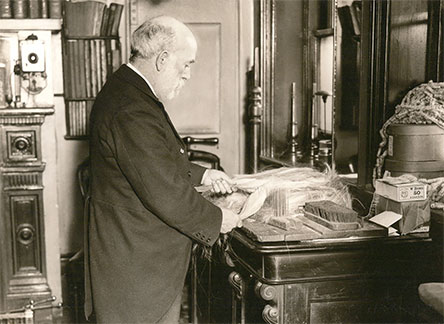
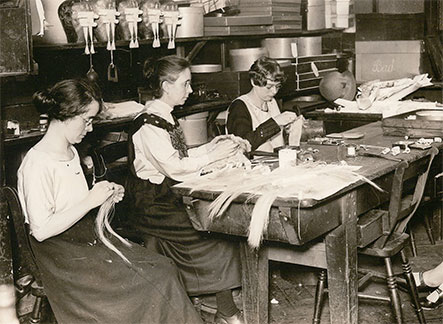
Ernest Ravenscroft (above) and Ede & Ravenscroft wigmaking staff (below), 1920s.
© Private Collection
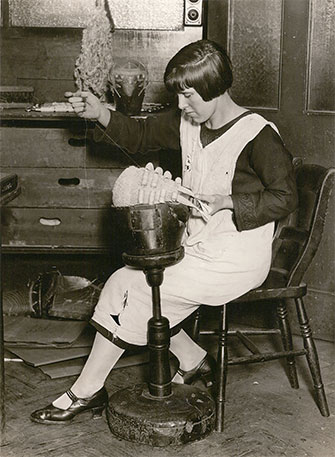
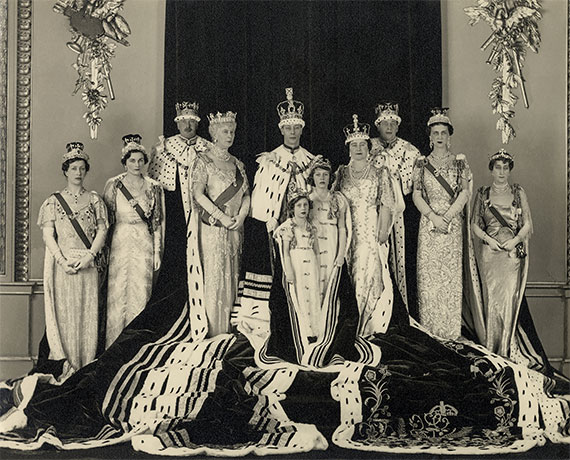
© E&R Archive and Collections
1930s
Ede & Ravenscroft's heritage
Rosa Ede died in 1931 and the firm passed to her nephew Stanley Ravenscroft. He successfully continued the business Rosa had nurtured, with Ede & Ravenscroft being appointed to undertake extensive robemaking for the Coronation of George VI in 1937.
Read More1930s
Ede & Ravenscroft's Heritage
On this occasion the coronation robes made by Ede & Ravenscroft included small capes and robes for the young Princesses Elizabeth and Margaret Rose, termed the ‘Little Princesses’ on the paper cut outs retained in the company Archive.
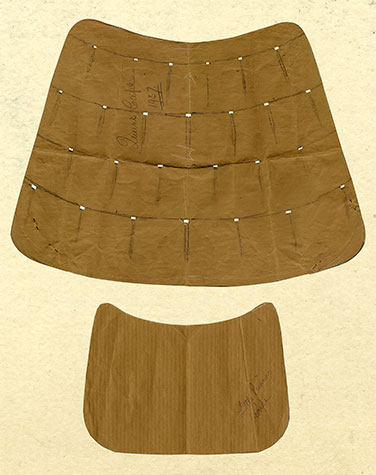
Paper cut-outs of the Queen’s and Princesses’ capes, 1937.
© E&R Archive and Collections
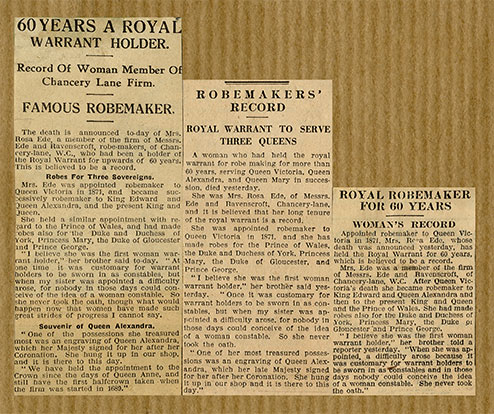
Press cuttings, 1931. © E&R Archive and Collections
Rosa Ede died in 1931, with obituaries appearing in the national press. By the time of her death she had managed the business for sixty years. During this period she had held the royal warrant continuously which the press claimed to be an unprecedented achievement.
After her death, Ede & Ravenscroft passed to her nephew Stanley Ravenscroft and stayed in the Ravenscroft family for a further forty years.
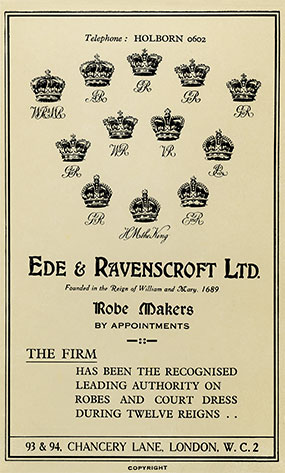
© E&R Archive and Collections
1940s
Ede & Ravenscroft's heritage
Ede & Ravenscroft applied for incorporation and in 1946 became a limited liability company, Ede & Ravenscroft Ltd. The first Board meetings of the new company included discussions on clothing coupons and the completion of war damage repairs to the Chancery Lane premises.
Read More1940s
Ede & Ravenscroft's Heritage
The company ledgers reveal that Ede & Ravenscroft was providing rabbinical clothing during the 1930s and 1940s for many of the London synagogues. Some of these clients were rabbis fleeing Nazi Europe such as Czech-born rabbi Irwin Landau who came to London in 1935, becoming rabbi of the Federation Synagogue in Neasden in 1942.
Although the company had produced Christian clerical vestments from its earliest days, up to this point it had not previously supplied Jewish robes in such quantities. The request for Ede & Ravenscroft to fulfil this function was perhaps due to the sudden influx of Jewish refugees combined with a decline in Jewish vestment manufacturing in Europe.
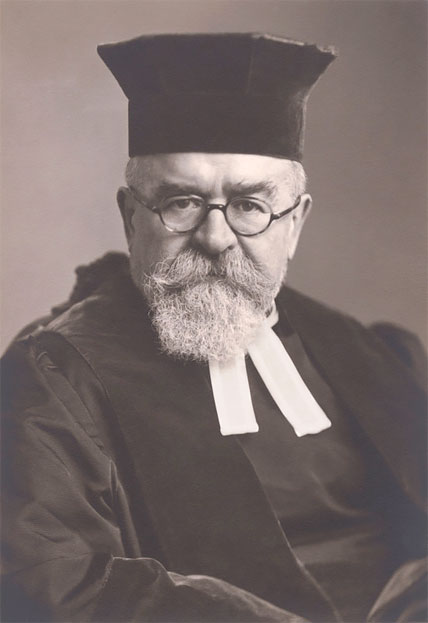
Joseph Herman Hertz, Chief Rabbi of the United Hebrew Congregations of the British Empire, 1913-1946, in rabbinical robes, an Ede & Ravenscroft client during this period. © National Portrait Gallery, London
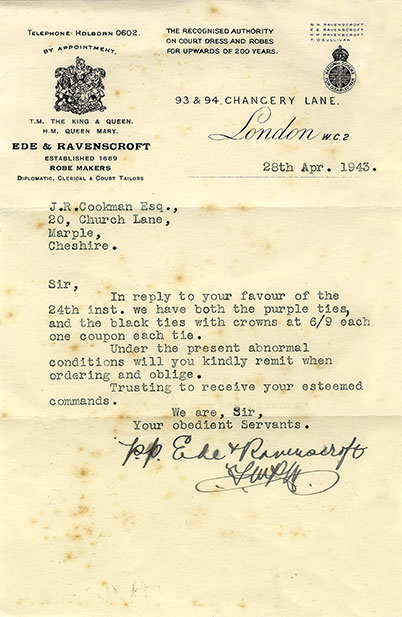
© E&R Archive and Collections
Ede & Ravenscroft continued to operate its tailoring business throughout the war, although, as this letter explains, under ‘abnormal conditions’. These included being required, along with other retail businesses, to operate a clothing coupon system. Clothes rationing was introduced in 1941 in response to shortages arising from a limited supply of fabric imports and raw materials and manufacturing capacity being focused on the war effort.
1940s
Ede & Ravenscroft's heritage
The Most Noble Order of the Garter ceremony and procession was revived and augmented by George VI in 1948 for the Order’s 600th anniversary celebrations, Garter Day continuing as an annual event ever since.
Read More1940s
Ede & Ravenscroft's Heritage
Although the Most Noble Order of the Garter is the oldest documented Order of Chivalry in the world, the formal installation of new Knights in a ceremony held in St George’s Chapel Windsor had been discontinued from 1805. George VI established the modern Garter ceremonial in 1948 by reviving both the installation of Knights and an annual Garter service of thanksgiving.
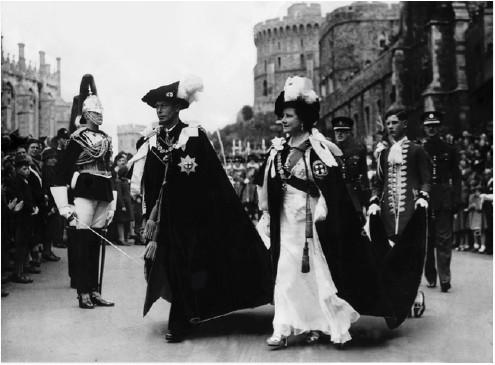
King George VI and Queen Elizabeth in Garter procession at Windsor, 1948.
© Trinity Mirror / Mirrorpix / Alamy Stock Photo
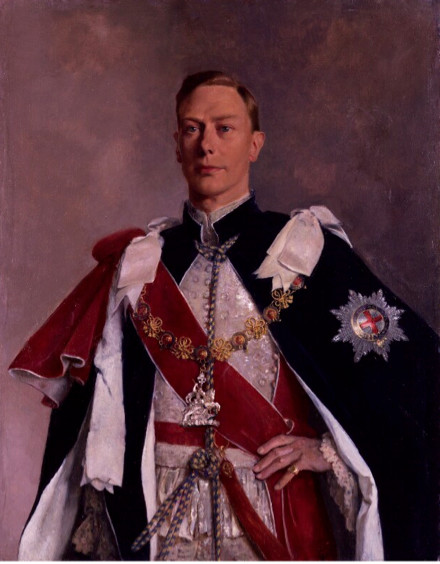
George VI, c 1941, in Garter robes made by Ede & Ravenscroft in 1935.
© Granger Historical Picture Archive / Alamy Stock Photo
Between the eighteenth to mid-twentieth centuries, the Sovereign was advised on appointments to Garter by the Government, the Order playing a role in international affairs as a means of securing overseas alliances. Ede & Ravenscroft’s late nineteenth century records contain references to Garter mantles for twenty foreign rulers, including Emperor Napoleon III of France; Emperor Alexander III of Russia; the Kings of Denmark, Hellenes, Italy, Netherlands, Portugal, Prussia, Sardinia, Saxony, Spain and Sweden; and the Shah of Persia.
George VI attached great importance to his position as Sovereign of the Order and in 1946 ensured that the Order reverted to being non-political, on the same basis as the Order of Merit, appointments thereafter being solely in the gift of the Sovereign.
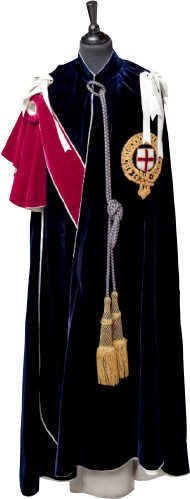
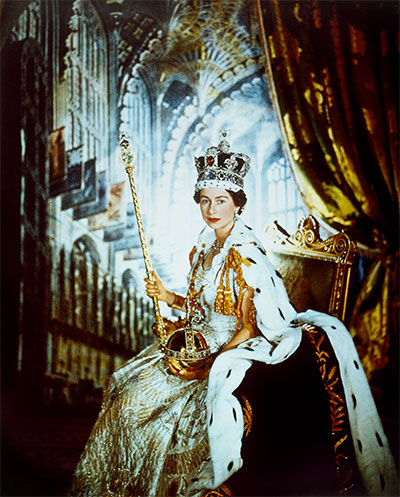
© Victoria and Albert Museum. London
1950s
Ede & Ravenscroft's heritage
In 1953 Ede & Ravenscroft was again entrusted with the robemaking for a coronation, including the robes for Queen Elizabeth II and her consort, The Duke of Edinburgh.
Read More1950s
Ede & Ravenscroft's Heritage
The Queen’s ceremonial robes, supplied by Ede & Ravenscroft, were among the central symbols in a ceremony witnessed by 27 million people, the Coronation being the first national televised event.
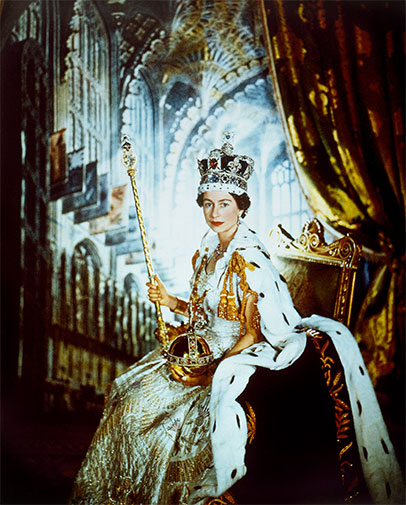
Coronation portrait of Queen Elizabeth II, 1953.
© Victoria and Albert Museum, London
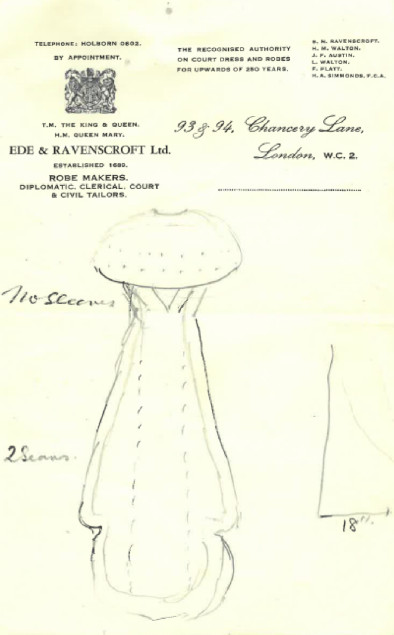
Ede & Ravenscroft sketch for alternative Coronation robes,
1952 © E&R Archive and Collections
For the 1953 Coronation, Norman Hartnell, designer of The Queen’s wedding and coronation dresses, designed an alternative style robe for peeresses, in consultation with Ede & Ravenscroft on the way in which the modifications could best be achieved. The new robe was designed to be sleeveless with a cape collar and cut all in one, unlike the traditional style robe with a separate kirtle, train and cape. This was the first major change in peeresses’ coronation robes since the reign of Queen Anne.
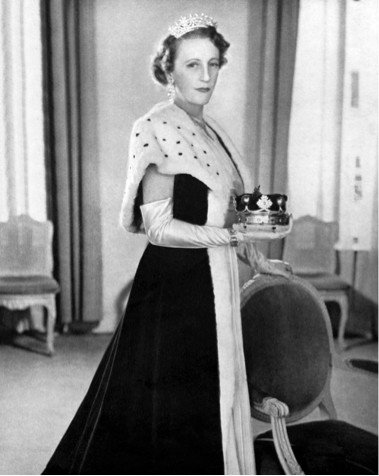
Lady Delamere wearing a new style robe. The Tatler, 10 June 1953.
© Illustrated London News Ltd/Mary Evans
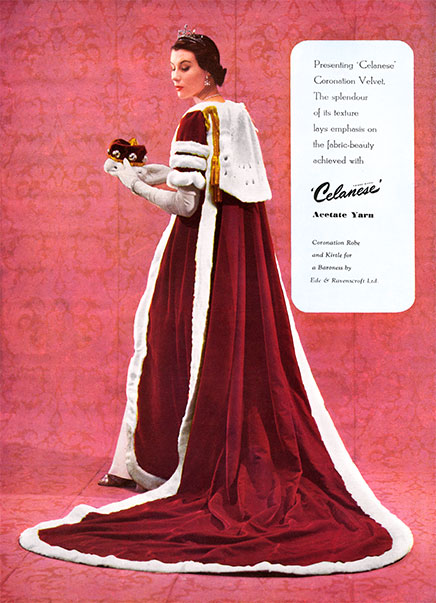
© Illustrated London News Ltd/Mary Evans
Ede & Ravenscroft has long had a reputation for using only the highest quality traditional fabrics in garment production, which continues to this day. But during the post-war period, synthetic fibre manufacturing revolutionised the mainstream dress industry by offering cheaper, more readily available alternatives. Cellulose acetate was one such fabric, produced by the Celanese company.
In 1953, just prior to the Coronation, Ede & Ravenscroft took part in a Celanese advertising campaign. Celanese ordered a coronation robe and kirtle made out of their own fabric in order to demonstrate its versatility and high quality, although failing to convince Ede & Ravenscroft of a switch away from traditional velvet.
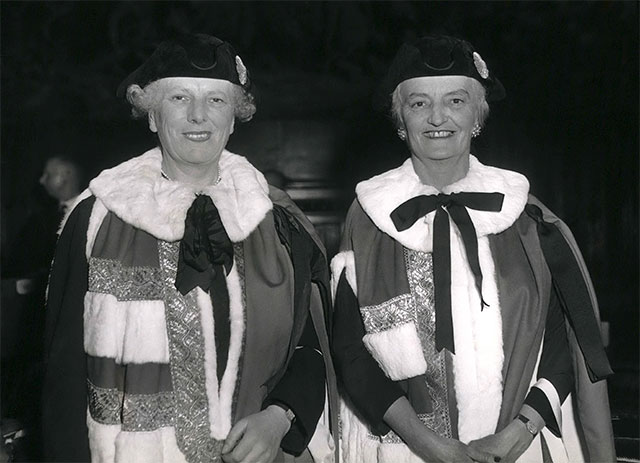
Baroness Elliott of Harwood and Baroness Ravensdale of Kedleston, two of the first four female peers created in October 1958. © Keystone Pictures USA / Alamy Stock Photo
1950s
Ede & Ravenscroft's heritage
In 1958, female peers were admitted to the House of Lords for the first time, through the Life Peerages Act.
Read More1950s
Ede & Ravenscroft's Heritage
In 1958, female peers were admitted to the House of Lords for the first time, through the Life Peerages Act. Ede & Ravenscroft was requested to produce female peers’ robes from a design proposed by Norman Hartnell, although the decision was subsequently made that men and women would wear identical parliamentary robes and the new designs were never produced.
Instead of replacing this traditional robe, a new style tricorn hat was designed and made by Ede & Ravenscroft exclusively for women peers to wear at their introduction to the House. These were worn until 1998 when the use of hats was discontinued.
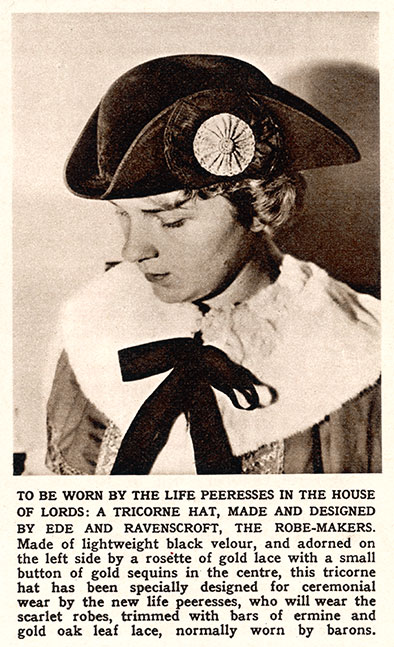
© Illustrated London News Ltd/Mary Evans
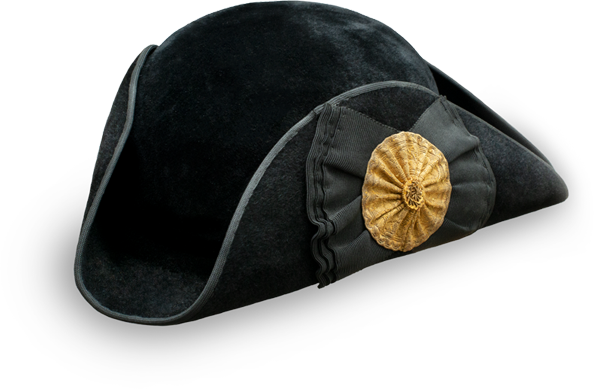
Female Peers tricorn hat, c1980s. © E&R Archive and Collections
Peers’ parliamentary robes have changed little since they were first introduced during the fifteenth century, consisting of a full-length scarlet robe with the degrees of peerage indicated by the number of bars which extend across the robe. Ede & Ravenscroft has produced, stored and hired out parliamentary robes to members of the House of Lords for many generations of peers, and continues this service to the present day, attending to the robing of 180 peers at the annual State Opening of Parliament.
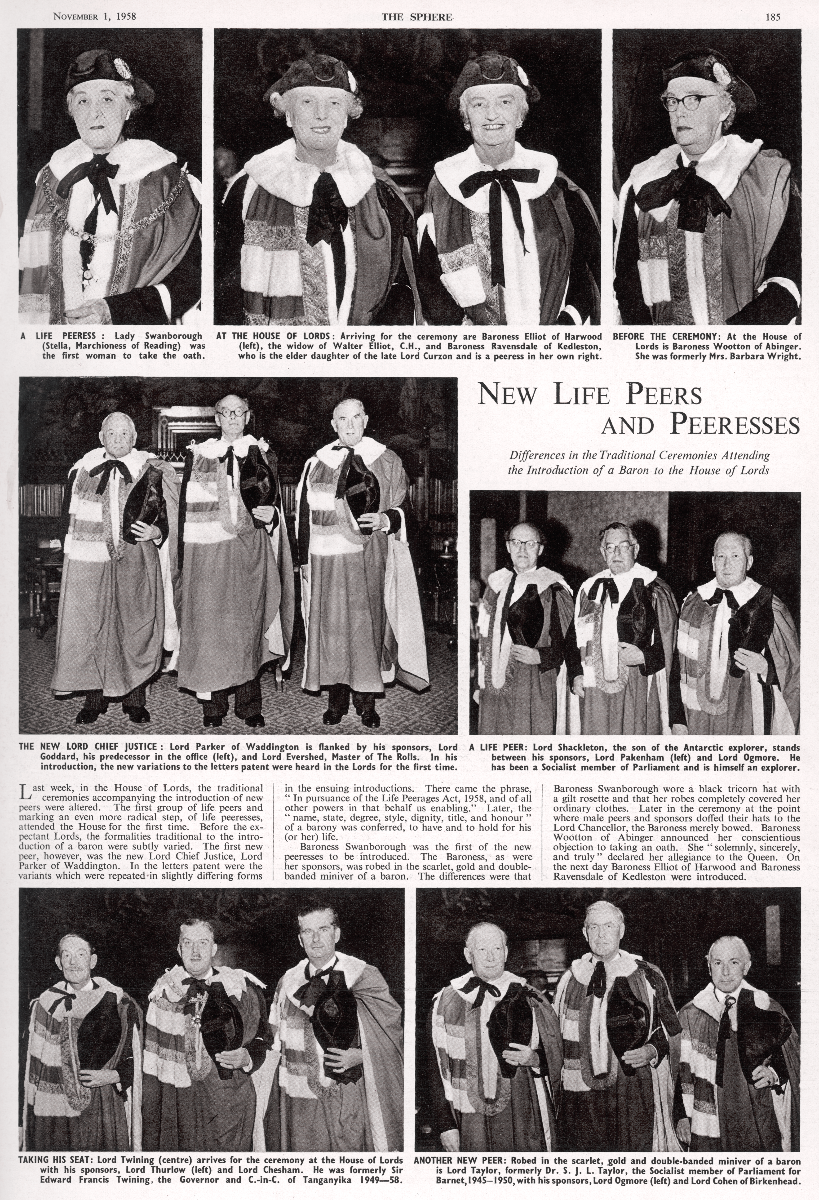
The Sphere, 1 Nov 1958. © Illustrated London News Ltd/Mary Evans
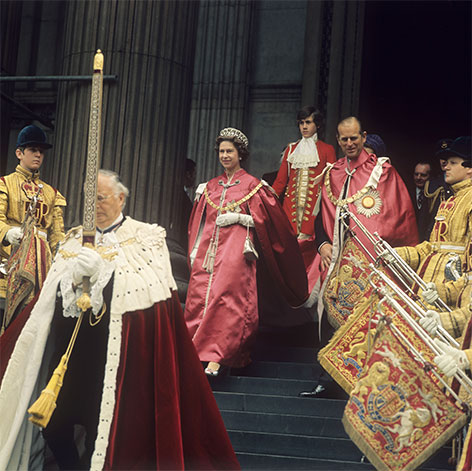
© Reginald Davis/REX/Shutterstock
1960s
Ede & Ravenscroft's heritage
During the 1960s the company combined the traditional with elements of modern innovative design in its robemaking.
Read More1960s
Ede & Ravenscroft's Heritage
The Order of the British Empire is a twentieth century Order of Chivalry established by George V in 1917. In 1960, The Queen’s mantle of the Order of the British Empire was made by Ede & Ravenscroft to a scheme by British designer Marion Foale, while a student at the Royal College of Art.
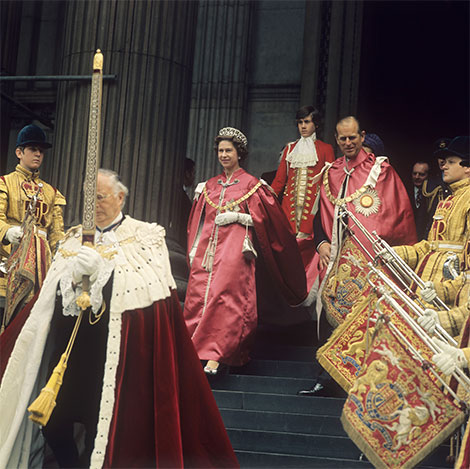
Queen Elizabeth II and The Duke of Edinburgh leaving St Paul’s Cathedral in robes of the Order of the British Empire after attending the service of dedication to the Order, 1974.
© Reginald Davis/REX/Shutterstock
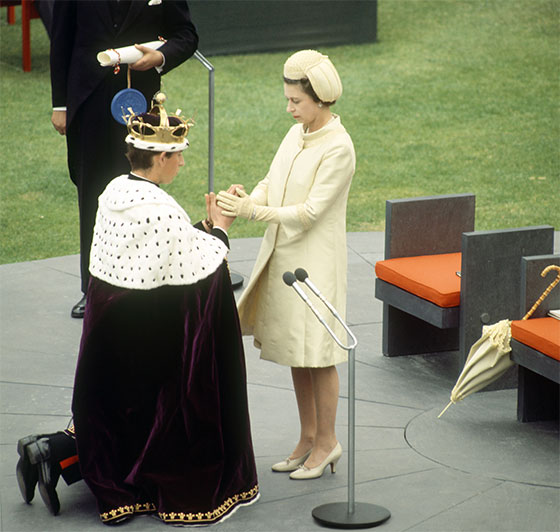
Investiture of The Prince of Wales, 1969.
© Reginald Davis/REX/Shutterstock
As for the previous Prince of Wales in 1911, the company was tasked with providing ceremonial dress for the Investiture of Prince Charles as Prince of Wales in 1969.
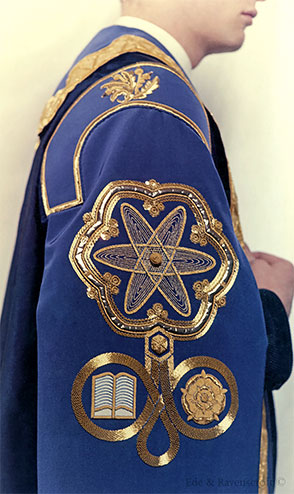
© E&R Archive and Collections
1960s
Ede & Ravenscroft's heritage
The substantial rise in student numbers during the 1960s and the creation of a number of new universities significantly increased demand for academic dress and for the provision of new academic dress schemes.
Read More1960s
Ede & Ravenscroft's Heritage
The expansion of higher education during the latter part of the twentieth century following the 1963 Robbins Report on Higher Education heavily impacted the work of Ede & Ravenscroft. During the 1960s, Ede & Ravenscroft created new dress schemes for the new institutions created during this period, often in association with designers such as Hardy Amies. Their remit was to retain something of traditional academic dress whilst reflecting a progressive outlook through contemporary design and distinctive colour schemes.
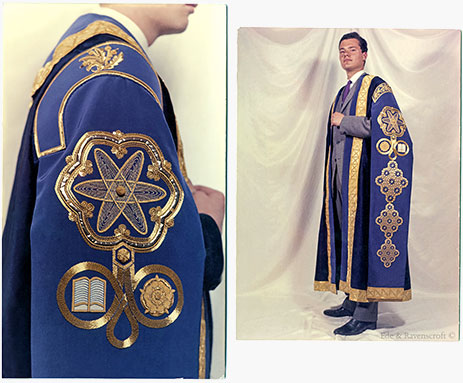
University of Salford Chancellor’s robes, 1967.
© E&R Archive and Collections
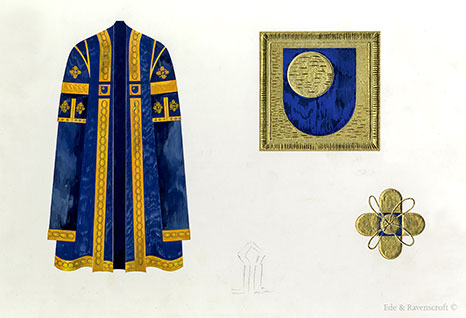
The Open University Chancellor’s robes, design work, c1969
© E&R Archive and Collections
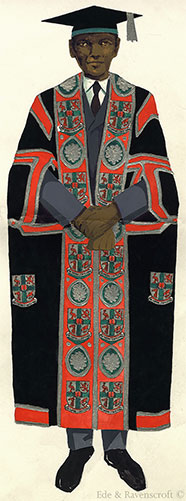
© E&R Archive and Collections
1960s - 1970s
Ede & Ravenscroft's heritage
The granting of independence to Commonwealth countries during the 1960s and 1970s led to a growth in overseas trade for Ede & Ravenscroft.
Read More1960s - 1970s
Ede & Ravenscroft's Heritage
During this period, Commonwealth countries formed their own executive legislatures, legal bodies and academic institutions, each requiring new schemes of dress. Ede & Ravenscroft was required to design schemes which combined aspects of British systems of dress, whilst incorporating local cultural design.
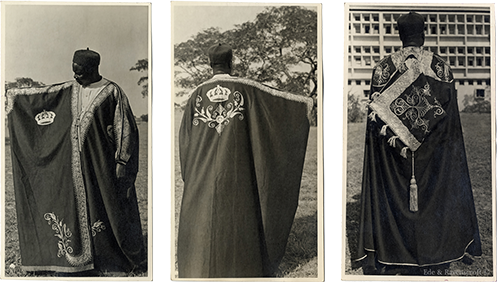
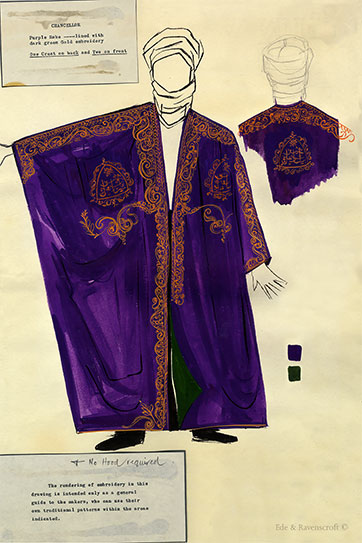
Ahmadu Bello University, Nigeria, Chancellor’s robes, 1960s.
© E&R Archive and Collections
The Ghanaian Speaker of the House of Assembly’s robes (below) incorporate a front facing of kente cloth, a distinctive traditional cloth associated with Ghana. The cloth is woven on a handloom in three inch wide long strips, in various brightly coloured patterns.
Ghana, Speaker’s robes, 1971.
© E&R Archive and Collections
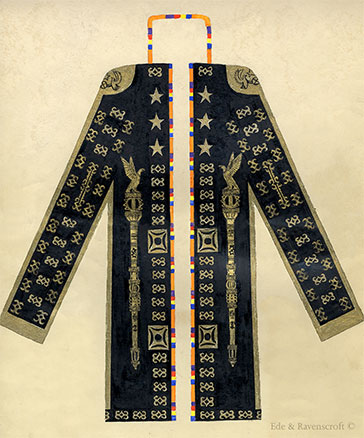
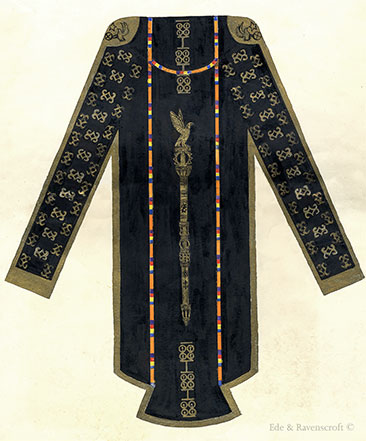
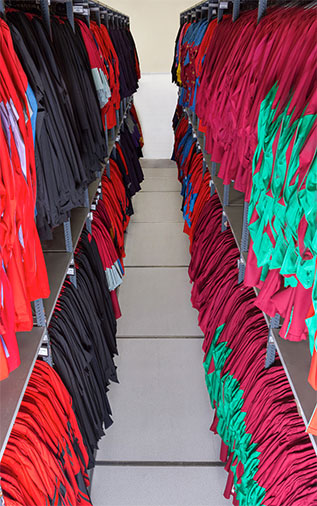
1980s
Ede & Ravenscroft's heritage
The expansion of Ede & Ravenscroft’s provision of the hire and sale of academic robes during the late twentieth century required the establishment of large warehousing facilities.
Read More1980s
Ede & Ravenscroft's Heritage
The company’s first warehouse was built in the early 1980s in Waterbeach, to the north of Cambridge. During the 1990s, further warehousing facilities were established in Grangemouth, Scotland in order to service academic institutions in Scotland and the north of England.
The company’s provision of graduation services continues to operate from Waterbeach and Grangemouth.
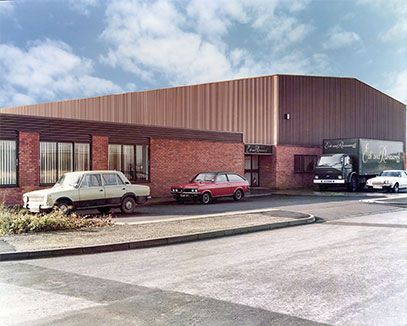
Academic warehouse, Waterbeach, c1982.
© E&R Archive and Collections
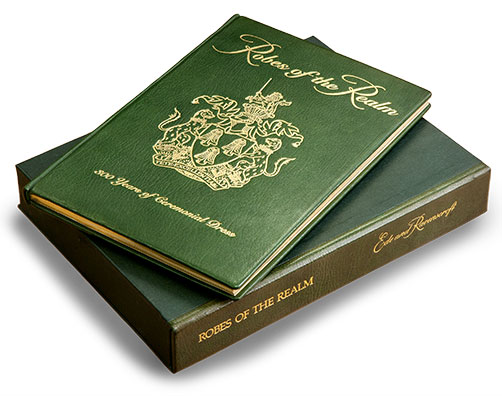
© E&R Archive and Collections
1980s
Ede & Ravenscroft's heritage
Ede & Ravenscroft celebrated its Tercentenary in 1989 with the publication of a book on the history of the company, Robes of the Realm, and a touring exhibition.
Read More1980s
Ede & Ravenscroft's Heritage
Patrick Lichfield was commissioned to take a series of photographs for Robes of the Realm, representing the diverse aspects of ceremonial dress made by the company throughout its history.
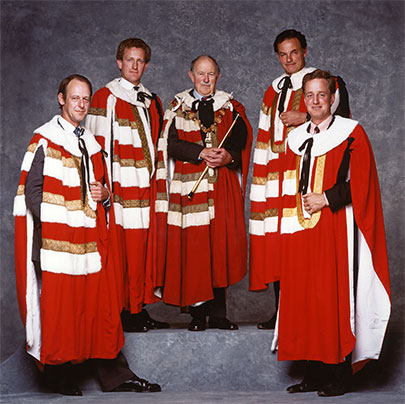
© E&R Archive and Collections
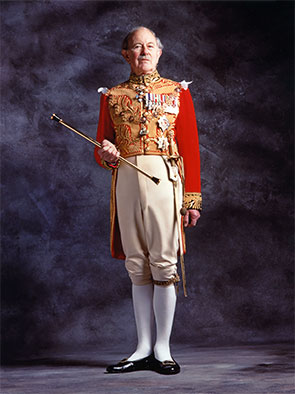
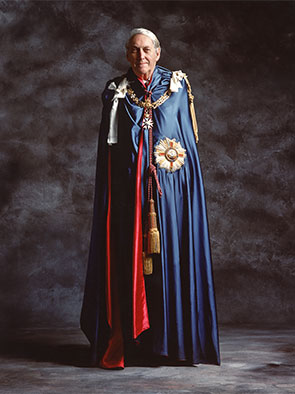
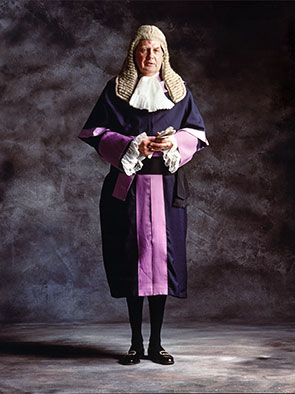
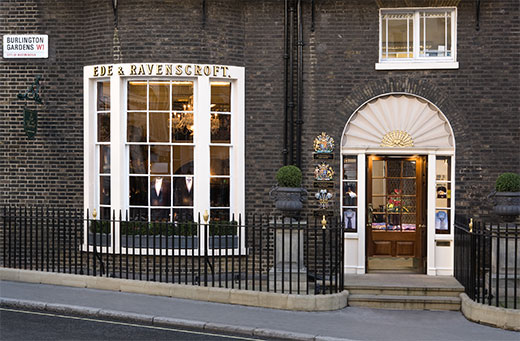
Ede & Ravenscroft shop, Burlington Gardens, Savile Row.
© E&R Archive and Collections
1980s
Ede & Ravenscroft's heritage
The expansion of the company’s retail outlets began during the 1980s, adding ready to wear formal and casual collections, whilst maintaining the company’s tradition of providing personal and bespoke tailoring services.
Read More1980s
Ede & Ravenscroft's Heritage
The opening of an Ede & Ravenscroft branch in Cambridge during the late 1980s was the first sales outlet to open since the Chancery Lane shop was established in 1868. Other outlets were opened in Oxford and Edinburgh during the 1990s, and during the 2000s further shops were opened in London, including the company’s first outlet on Savile Row.
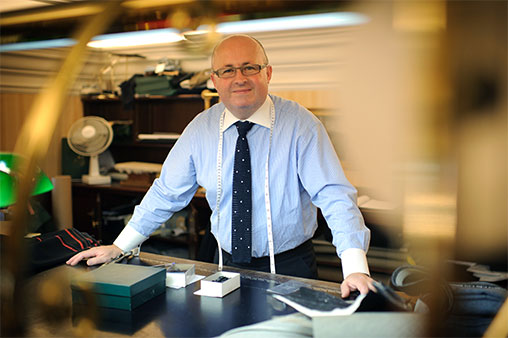
© E&R Archive and Collections
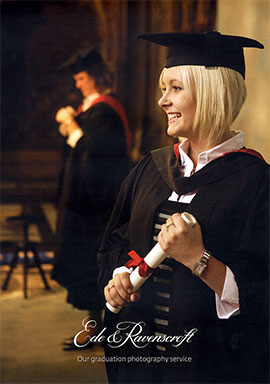
© E&R Archive and Collections
1990s
Ede & Ravenscroft's heritage
Ede & Ravenscroft further expanded its graduation services by offering event photography for the first time during the 1990s. Ede & Ravenscroft Photography was established in 1997, providing a single point of contact for graduands to obtain both academic dress and graduation photographs.
Read More1990s
Ede & Ravenscroft's Heritage
Ede & Ravenscroft’s first website was developed during this period, offering online ordering and purchasing for all aspects of the business. Online ordering was particularly complementary to the company’s expanding provision of graduation services, transforming the speed in which transactions could be processed.
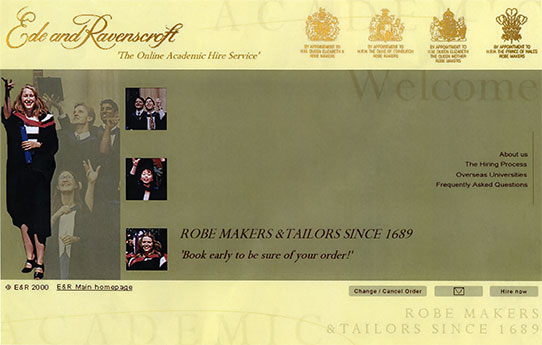
© E&R Archive and Collections
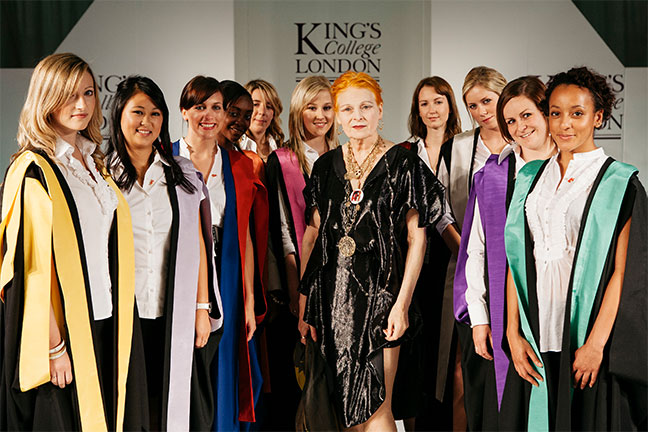
© Greg Funnell
2000s
Ede & Ravenscroft's heritage
The 2000s saw Ede & Ravenscroft continue to incorporate modern design trends into academic dress, working with iconic British fashion designers such as Betty Jackson, Dame Zandra Rhodes and Dame Vivienne Westwood.
Read More2000s
Ede & Ravenscroft's Heritage
In 2007 King’s College London was granted degree awarding powers and required a new scheme of academic dress. Ede & Ravenscroft worked closely with Vivienne Westwood in order to create a distinctive and contemporary design which incorporated gold King’s Lion buttons on each shoulder, with the hood fastened to the buttons, and the cowl bindings with the relevant school colour extending down the front of the gown.
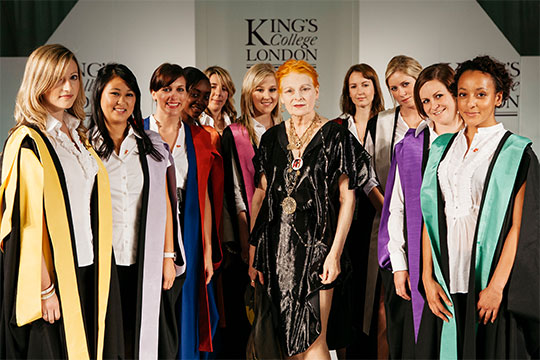
© Greg Funnell
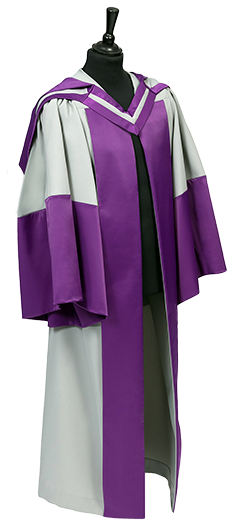
The Duke of Edinburgh’s Honorary Doctorate robe, London Metropolitan University, 2003
© E&R Archive and Collections
London Metropolitan University’s strikingly modern silver and purple colour scheme was incorporated into their academic dress, as shown here in The Duke of Edinburgh’s honorary doctorate robe. As the then patron, he was awarded the first degree given by the new university in 2003.

2010s
Ede & Ravenscroft's heritage
Having outgrown premises in Peterborough, in 2013 the company created new state of the art photography laboratory facilities near Cambridge, allowing further improvements to be made to its photographic services.
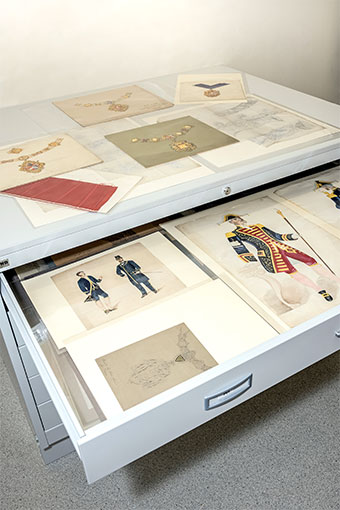
2010s
Ede & Ravenscroft's heritage
In 2014 a purpose-built archive strongroom was established to house Ede & Ravenscroft’s wealth of historic written records, documenting the activities of the business from 1741.
Read More2010s
Ede & Ravenscroft's Heritage
In order to ensure the preservation of Ede & Ravenscroft’s corporate legacy, the company set up a formalised management of its archive and dress collections during the 2010s. The collections represent a vital resource for the history of the company, and for wider aspects of business and social history, documenting ceremonial dress and custom over a period of almost 300 years.
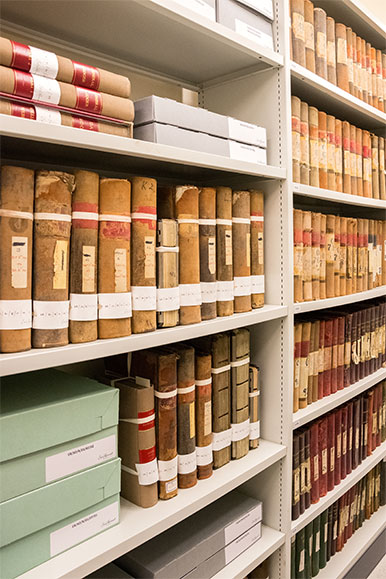
OUR TIMELINE
c1640
ede's heritage
The business which later became Ede robemakers was established by the Shudall family during the seventeenth century.
Read Morec1640
ede's heritage
The Shudalls operated as respected tailors, robemakers and haberdashers from the area around Holywell Street, near the Strand, the centre of the tailoring trade in London during the seventeenth century.

Charles Shudall trade card, c1730.
© City of Westminster Archives

Holywell Street, 1816. © London Metropolitan Archives
1689
Ede's heritage
By the late seventeenth century the Shudalls had obtained royal patronage, receiving a commission as robemakers for the Coronation of William III and Mary II.

© National Portrait Gallery, London

© E&R Archive and Collections
1726
Ravenscroft's heritage
In 1726 Thomas Ravenscroft founded a wigmaking business in Serle Street, Lincoln’s Inn.
Read More1726
Ravenscroft's heritage
The Ravenscroft wigmaking business was established by Thomas Ravenscroft in 1726 and operated independently until merging with the robemakers Ede & Son in 1902.
Although the wearing of wigs as a fashion accessory was on the wane by the late eighteenth century, Ravenscroft’s location, close to the Inns of Court in London, meant that the business was able to prosper by supplying wigs to the legal profession.

Ravenscroft shop sign, 19th century. © E&R Archive and Collections

© National Portrait Gallery, London
1750s - 1760s
Ede's Heritage
The robemaking business continued to flourish throughout the eighteenth century, and in 1761 received an appointment to make the coronation robes for George III.
Read More1750s - 1760s
Ede's Heritage
Husband and wife, William and Martha Shudall were running the business by the mid eighteenth century. They maintained their reputation as specialist robemakers, with William regularly attending to the robing of the Order of the Garter ceremony at Windsor Castle. William died in 1757, and Martha continued the business in partnership with Francis Stone.

Trade Cards, William Shudall; Shudall and Stone, c1750-1760s.
© The Trustees of the British Museum

Ledger detailing specifications for George III's coronation robes, 1761.
© E&R Archive and Collections
During this period their largest appointment was to make the coronation robes for the Coronation of George III in 1761. The coronation robes are detailed in the company ledgers, and as well as the robes for the King and Queen Charlotte, the ledger also shows accounts for coronation robes for sixteen other dukes and 46 earls. Together with other degrees of peerage the total number of robes made for the coronation was well over a hundred.
1790s - 1810s
ede's heritage
William Webb inherited the robemaking business in 1797, after the death of his father-in-law Francis Stone. He continued to build on the success of his predecessors, receiving a royal warrant from George III as official robemaker.
Read More1790s - 1810s
Ede's Heritage
For over 200 years, the business has supplied officers of the College of Arms with ceremonial dress. The Kings of Arms, Heralds and Pursuivants are a distinctive sight on state occasions in their vividly coloured medieval-style tabards. Their dress indicates the long standing nature of their office as organisers of state ceremonial events and experts in armorial matters, having authority to grant new arms and confirm proven pedigrees and claims to existing arms.
In Scotland, the Lord Lyon King of Arms similarly oversees state ceremonial, with heraldic responsibility extending to the registering and recording of new clan tartans, upon the request of the clan chief.

Tabard design approved by the College of Arms, 1883.
© E&R Archive and Collections

Lord Lyon King of Arms tabard, late 19th century, worn by Sir James Balfour-Paul during his tenure of office as Lord Lyon, 1890-1926. Sir James was on duty at the Coronations of Edward VII and George V, and at the state funerals of Queen Victoria and Edward VII. © E&R Archive and Collections

Herald’s tabard, early 20th century.
© E&R Archive and Collections

© E&R Archive and Collections
1790s - 1810s
ede's heritage
William Webb continued the business of supplying chivalric robes, a tradition which Ede & Ravenscroft maintains to this day.
Read More1790s - 1810s
Ede's Heritage
During this period, both George III and IV embraced the revival of the medieval chivalric orders, enlarging the membership of traditional orders and establishing the (now dormant) Order of St Patrick in 1783 and the Order of St Michael and St George in 1818, with further orders created by successive monarchs during the nineteenth and twentieth centuries.

Order of St Michael and St George mantle,
early 20th century. © E&R Archive and Collections
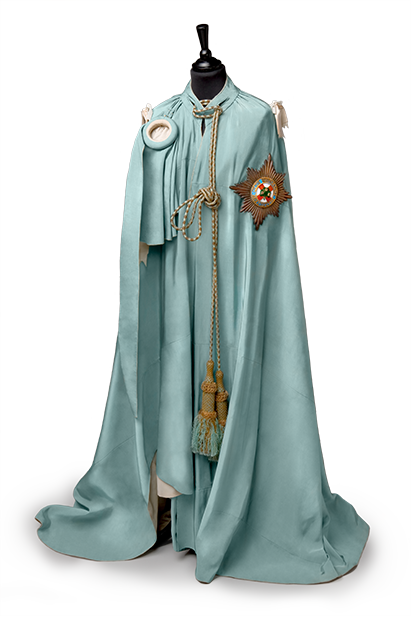
Order of St Patrick mantle, early 20th century.
© E&R Archive and Collections
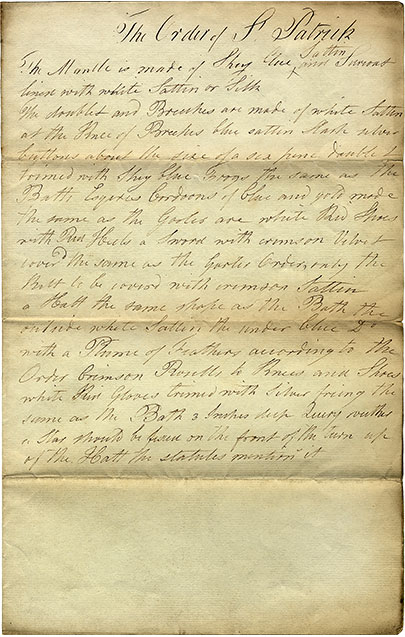
William Webb’s making instructions for the Order of St Patrick sky blue mantle, 1809. © E&R Archive and Collections
Order of the Bath, mantle design drawing, 1911.
© E&R Archive and Collections
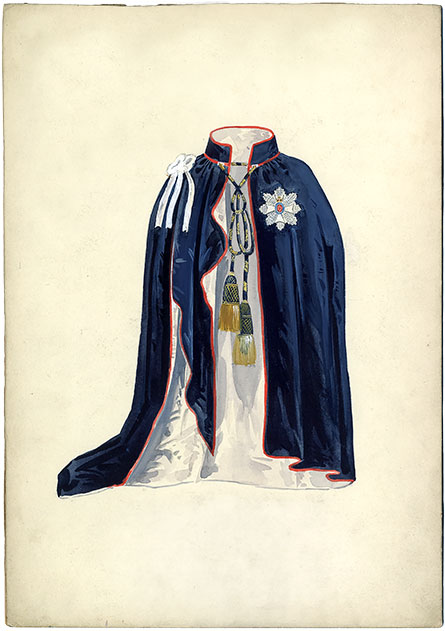
Letter from Lord Nelson requesting an Order of the Bath mantle be delivered to Mr Webb, robemaker, 1803. © E&R Archive and Collections


© E&R Archive and Collections
1820s
ede's heritage
William Webb obtained a royal warrant from George IV early in his reign, in 1820, and was then appointed to work as robemaker for the lavish Coronation in 1821.
Read More1820s
Ede's Heritage
William Webb became a key figure in creating the King’s vision of using chivalric pageantry for the Coronation, and was requested to provide hundreds of mantles for knights and officers of the orders of chivalry. The business also supplied peers’ coronation robes, including the dress worn by the eight eldest sons of peers’ in attendance to the King.

Esquire’s dress for the Order of the Bath, c1821, Wm Webb.
© E&R Archive and Collections

Sons of peers’ coronation underdress for Coronation of George IV, 1821, Wm Webb. © E&R Archive and Collections
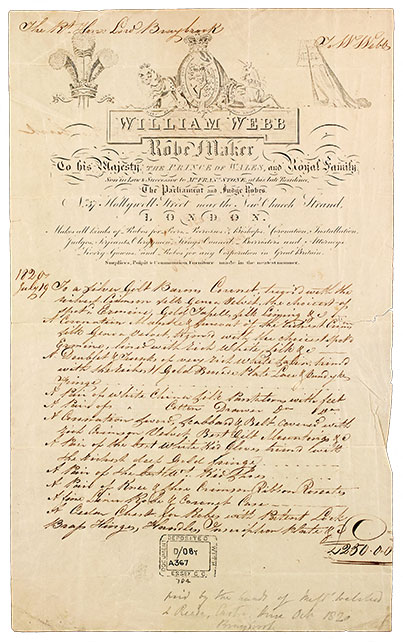
Invoice to Lord Braybrook, Jun 1820, detailing purchases made for coronation dress.
© Reproduced by courtesy of the Essex Record Office

© E&R Archive and Collections
In 1827 William Webb acquired new premises at 193 Fleet Street, the first move away from Holywell Street since the establishment of the business in the seventeenth century.

© E&R Archive and Collections
1820s
Ravenscroft's heritage
The Ravenscroft wigmaking business continued to thrive during the nineteenth century, due in part to the invention by Humphrey Ravenscroft of the patent forensic wig.
Read More1820
Ravenscroft's heritage
Humphrey Ravenscroft (grandson of the founder Thomas Ravenscroft) pioneered the so-called forensic wig in 1822. This finally dispensed with the inconvenience of maintaining a wig, which involved treating it almost daily with a thick scented ointment and powder. The curls of the new patent wig were also set, which meant that the horsehair did not need to be daily frizzed and curled back into place. The innovation was an immediate success.

Ravenscroft’s forensic wig patent, 1822.
© E&R Archive and Collections

© E&R Archive and Collections
1830s
Ravenscroft's heritage
Following the success of his barrister’s wig, Humphrey Ravenscroft went on to develop an equivalent full-bottomed judge’s wig in 1835.
Ravenscroft’s advertisement for the new wig declared his new design to be ‘the highest state of perfection’, being ‘remodelled and executed on an entirely new principle’.
Read More1830
Ravenscroft's heritage

Speaker of the House of Commons, 1861, Rt Hon J E Denison, wearing full-bottomed wig. From a series of legal portraits collated by Burton Ravenscroft during the mid-19th century.
© E&R Archive and Collections

Ravenscroft advertisement for the patent forensic full-bottomed wig, 1835.
© E&R Archive and Collections

Lord Denning’s wig, late 20th century.
© E&R Archive and Collections
1830s - 1850s
Ede's heritage
William Webb’s apprentice, Joseph Ede, acquired the business in 1834 with his uncle Thomas Adams. They upheld the robemaker’s unbroken record as royal warrant holders, successively obtaining William IV’s warrant in their first year of trading, and Queen Victoria’s in the first year of her reign in 1837.
Read More1830s - 1850s
Ede's Heritage
William Webb died in 1831 and the business passed to his son Frederick, assisted by Joseph Ede, an apprentice who had been taken on in 1811.
In 1834 Webb’s business was acquired by Thomas Adams, Joseph Ede’s uncle, and began trading as Adams & Ede.
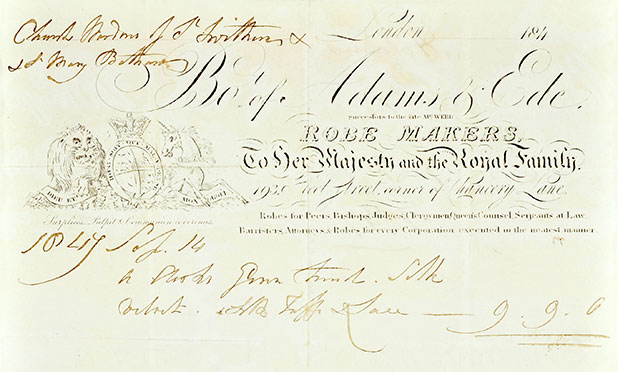
Adams & Ede invoice to the churchwarden’s of St Swithins with St Mary Bothaw, 1847.
© London Metropolitan Archives

Dimensions of Her Majesty’s State Robes, 1879 (taken from 1838 ledger).
© E&R Archive and Collections
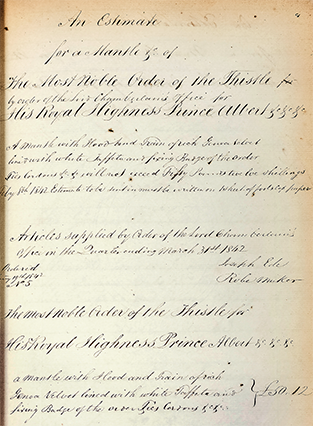
Estimate for Prince Albert’s thistle mantle, 1842.
© E&R Archive and Collections
Joseph Ede eventually took over and the firm took the name ‘Joseph Ede’ in 1848. He received a series of warrants from Queen Victoria, the business continuing to expand and prosper throughout the nineteenth century.

Estimate for mourning cloaks for mourners of the Duke of Wellington, 1852.
© E&R Archive and Collections
Between the mid to late nineteenth century, strict adherence to the rituals and customs of mourning, particularly in dress, reached its height. Consequently, the correct fulfilment of mourning dress etiquette became an important part of the tailoring industry. Joseph Ede’s ledgers for this period contain hundreds of orders for mourning bands and ‘weepers’, cuffs of ruffled white lace worn over the sleeves, worn at court during periods of national mourning.
Day Book, 21 Jun 1837. Orders for mourning bands and weepers worn at court after the death of William IV.
© E&R Archive and Collections
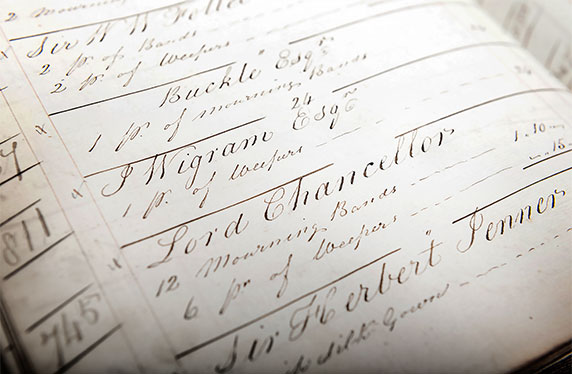

© Lordprice Collection/Alamy Stock Photo
1830s - 1850s
Ede's heritage
The 1835 Municipal Corporations Act established many new mayoralties throughout Britain and led to an increase in demand for new civic robes.
Read More1830s - 1850s
Ede's Heritage
Ede & Ravenscroft has long been robemakers to the Corporation of London, making robes for the City livery companies as well as the Lord Mayor and officials. However, the Municipal Corporations Act of 1835 established a system of municipal boroughs throughout the country, governed by town councillors requiring civic robes. The business was subsequently required to supply robes for the officials of 390 boroughs across the country, with the addition of 28 London boroughs.

Design specifications for civic robes, late 19th century.
© E&R Archive and Collections

Ward Beadle’s cape coats, City of London, early 20th century.
© E&R Archive and Collections

City of London Alderman’s robe, mid 19th century; City of London Master/Warden’s livery robe, early 20th century. © E&R Archive and Collections

© E&R Archive and Collections

© E&R Archive and Collections
1860s
Ede's heritage
Joseph Ede’s son Joseph inherited the business and, trading as Ede & Son, relocated to 93/94 Chancery Lane in 1868.
Read More1860s
Ede's Heritage
Joseph died in 1862 and his widow Anne took over the business for a short time. By 1868 their son Joseph Webb Ede had taken over (his middle name ‘Webb’ given in memory of his father’s former employer William Webb), renaming the firm ‘Ede & Son’.

Ede & Son catalogue, 1896.
© E&R Archive and Collections

Elevation of 94 Chancery Lane, 1814.
© Magdalen College, Oxford
In 1868 Ede & Son relocated to nos 93-94 Chancery Lane which is where the company head office is still located. This proved to be a well-chosen location situated close to the Inns of Court, legal dress being then, as now, an important part of the business, supplying the full range of legal clothing from plain back barrister’s robes through to the highly embellished black and gold robes of the senior judiciary. Up to 1933, the business supplied all judges on appointment with a definitive guide to dress regulations entitled the ‘Judges’ Robing List’.

The Master of the Rolls state robe, c1910, Ede, Son and Ravenscroft.
© E&R Archive and Collections

Ede & Son Judges’ Robing List, late 19th century.
© E&R Archive and Collections

Rosa Ede (née Ravenscroft), c1890s.
© E&R Archive and Collections
1870s - 1890s
Ede's heritage
In 1871 Joseph Webb Ede of the robemaking business Ede & Son married Rosanna Ravenscroft (Rosa Ede), daughter of Burton Ravenscroft of the wigmaking Ravenscroft business, beginning an association of the two local, complementary trades.
Read More1870s - 1890s
Ede's Heritage
The marriage between Joseph Webb Ede and Rosanna Ravenscroft was a significant event, uniting the two trades, although a formal merger was a number of years later, in 1902.
However, Joseph died six months into the marriage, at the age of 26, leaving his widow Rosa Ede to take over the robemaking business. Queen Victoria confirmed the appointment of Rosa Ede as her new robemaker in September 1871, and Rosa went on to manage the business for sixty years.

Memorial card, Joseph Webb Ede, 1871.
© E&R Archive and Collections

Hugh Enes Blackmore as Sir Bailey Barre QC in the premiere of Gilbert and Sullivan’s Utopia Ltd in 1893, wearing costume provided by both Ede & Son, and Ravenscroft wigmakers.
The company has long provided costume for theatre, television and film. As early as the 1890s, garments were provided for original productions of the D’Oyly Carte Opera Company’s Iolanthe and Utopia Limited at the Savoy Theatre, to W S Gilbert’s own specifications.

© E&R Archive and Collections
1870s - 1890s
Ede's heritage
By the 1870s Ede & Son was supplying academic dress to more than twenty universities throughout Britain.
Read More1870s - 1890s
Ede's Heritage
The business supplied academic dress to the universities of Oxford and Cambridge from its inception, but this trade gradually expanded over the course of the nineteenth and early twentieth centuries when a number of new universities, such as the University of London, were founded.

Design for University of London, Chancellor’s robe, 1955.
© E&R Archive and Collections

Academic dress designs, early 20th century.
© E&R Archive and Collections
1870s - 1890s
Ede's heritage
Queen Victoria instituted two new orders of chivalry during the late nineteenth century, both of which were associated with the Indian Empire.
Read More1870s - 1890s
Ede's Heritage
The Most Exalted Order of the Star of India was founded in 1861, its insignia (badge and star) being the most costly of any order of chivalry at the time of their introduction, being set with diamonds. In 1886, the Most Eminent Order of the Indian Empire was founded, its mantle a deep blue silk lined with white.
Many of the Indian princes and maharajas were appointed to these orders which were also open to British subjects who had rendered valuable service to the Empire in India.

The Most Exalted Order of the Star of India, Knight Grand Commander, (GCSI); mantle with badge and cordons.
© E&R Archive and Collections

The Most Eminent Order of the Indian Empire, Knight Grand Commander, (GCIE); mantle with badge and cordons.
© E&R Archive and Collections
Correspondence confirming Ede & Son as robemakers to Sir Bhagwat Singhji, 1897.
© E&R Archive and Collections

H.H Maharaja Thakore Shri Sir Bhagwat Singhji Sagramji Sahib Bahadur, Maharaja of Gondal GCSI, GCIE (then a GCIE), wearing robes of the Knight Grand Commander of the Order of the Indian Empire during his visit to London for the Coronation of King George V in 1911. © Victoria and Albert Museum, London


© E&R Archive and Collections
1900s
Ede & Ravenscroft's heritage
1902 saw the official merger of the robe and wig making firms, becoming Ede, Son & Ravenscroft, and the Coronation of Edward VII, for which the business was required to undertake considerable work.
Read More1900s
Ede & Ravenscroft's Heritage
Ede, Son & Ravenscroft was responsible for a large proportion of the robemaking for the Coronation of Edward VII, the requirements for which were considerable due to there not having been a coronation since 1838. Entries in the company ledgers list the extensive work required for Edward VII and Queen Alexandra’s robes, as well as robes for peers, officers of state, bishops and clergy. The company was also commissioned to supply altar cloths and velvet to upholster the coronation chairs.

Letter from Harriet Giltrap, dresser to Queen Alexandra, confirming Ede & Son to supply the Queen’s coronation robes, 1901. © E&R Archive and Collections

Queen Alexandra in coronation robes, 1902.
© E&R Archive and Collections
In 1902 the two companies officially merged: Ede & Son, robemakers, with Ravenscroft, wigmakers. Burton Ravenscroft, Rosa’s eldest brother, had taken over the wigmaking business in Serle Street, and he now moved it to premises at 1 Star Yard, backing onto Ede & Son’s Chancery Lane shop. With the merger came a change of name, to Ede, Son & Ravenscroft.

© E&R Archive and Collections

© E&R Archive and Collections
1900s
Ede & Ravenscroft's heritage
Between the mid nineteenth and early twentieth centuries the wearing of court dress while in attendance at the royal court, and diplomatic uniforms for diplomats and consuls, reached its height.
Read More1900s
Ede & Ravenscroft's Heritage
Ede & Ravenscroft has long provided and continue to supply court dress, worn today by the Queen’s Counsel and some judges, and the Serjeant and Assistant Serjeant at Arms of Parliament, and select officials on formal state occasions.

Privy Councillor’s full dress uniform, 1st Class, early 20th century.
© E&R Archive and Collections

Greek Diplomatic uniform, early 20th century.
© E&R Archive and Collections
During the nineteenth century, diplomatic uniforms were introduced for diplomats and consuls to wear on public occasions. Based on court dress, diplomatic dress was similarly abandoned by most countries during the twentieth century. Although it began as a European style dress, many non-European states also adopted the uniform. As well as providing many European countries with diplomatic uniform, Ede, Son & Ravenscroft made dress for the diplomatic and consular services of countries such as Argentina, China, Ecuador, Panama, Persia and Venezuela.
Diplomatic dress followed nineteenth century court fashion, and was richly decorated with gold embroidery indicating rank and particular to each country; for example, the Norwegian diplomatic uniform incorporated a pine cone embroidery design, the Greek diplomatic uniform an olive leaf design.

Designs for Norwegian Consul-General uniform, 1906.
© E&R Archive and Collections

Persian Consul-General illustration, early 20th century.
© E&R Archive and Collections

© E&R Archive and Collections
1910s
Ede & Ravenscroft's heritage
The Coronation of George V in 1911 required Ede, Son and Ravenscroft to make adjustments to existing robes used for the previous coronation ceremony, nine years earlier.
Read More1910s
Ede & Ravenscroft's Heritage
With another coronation only nine years since the previous ceremony, there was little new robemaking to be done for this event. Ede, Son and Ravenscroft was required to make adjustments to existing robes, and even the robes worn by Edward VII and Queen Alexandra at the previous coronation were adapted by the company to be worn by George V and Queen Mary.

Ede, Son and Ravenscroft employees preparing for 1911 Coronation.
© E&R Archive and Collections


Tassels for Queen Mary’s coronation robes, 1911.
© E&R Archive and Collections
As robemakers to the Prince of Wales (later Edward VIII), the company made the Order of the Garter robes he wore at the coronation of George V in June 1911, and the velvet robes for his investiture at Caernarvon in July of the same year.

Prince Edward of Wales with Princess Mary, the Princess Royal, at the coronation of their parents, 1911.
© E&R Archive and Collections

© E&R Archive and Collections
1910s
Ede & Ravenscroft's heritage
The rise of the women’s emancipation movement in Britain required Ede, Son and Ravenscroft to provide academic and ceremonial robes to a wider female clientele.
Read More1910s
Ede & Ravenscroft's Heritage
With a woman at the helm for the previous forty years the provision of female academic dress was a task the business embraced, providing graduate robes for the Women’s Suffrage Procession in 1911.
The 1911 Women’s Coronation Procession was the largest demonstration up to that time in support of British women’s suffrage. Forty thousand women participated in the march in London, in which the processing of graduate suffragists in their academic hoods and robes was an important visual and symbolic act.
Written the day before the procession took place and a week before the Coronation itself, this letter details arrangements for the hire of academic gowns from Ede, Son and Ravenscroft by the London Graduates’ Union for Women’s Suffrage, thanking the company for coming to their assistance.

Suffragists in academic robes, Coronation Procession, 1911.
© Museum of London

© E&R Archive and Collections
The admission of women into the male chivalric orders began in 1917, with the introduction of the Order of the British Empire, the title of Dame becoming an official equivalent of Knight. This was subsequently extended to other orders, the Royal Victorian Order first admitting women in 1936, the Order of St Michael and St John in 1965, and the Order of the Bath in 1971. In 1987 women were first eligible to be installed into the Orders of the Garter and Thistle as Ladies Companion, on equal terms with their male counterparts.

Royal Victorian Order, Dame Grand Cross, ladies’ mantle. Formerly belonging to Helen Percy, Duchess of Northumberland, c1938.
© E&R Archive and Collections

© E&R Archive and Collections
1920s
Ede & Ravenscroft's heritage
In 1921 the business was officially renamed Ede & Ravenscroft.
Read More1920s
Ede & Ravenscroft's Heritage
At the beginning of the twentieth century, all female academic robes were a distinct ankle length design in order to cover a full skirt length. As hemlines rose during the 1920s, so too could female academic dress, and by the 1930s academic robes had become a largely unisex style.

Gown and hood purchased by Miss F A Taylor for award of a Bachelor of Commerce degree (now obsolete in the UK) from the University of London, 1928, with invoice © E&R Archive and Collections


Lancaster College of Music graduate, c1920s.
© E&R Archive and Collections

© E&R Archive and Collections

© Private Collection
1920s
Ede & Ravenscroft's heritage
Throughout the early decades of the twentieth century, Rosa Ede continued to run the robemaking side of the business with her brothers Clement and Vernon Ravenscroft, while her brothers Burton and Ernest Ravenscroft managed the wigmaking.
Read More1920s
Ede & Ravenscroft's Heritage
Wigs continued to be made according to Humphrey Ravenscroft’s original patents, and from these same premises in Chancery Lane the processes established in 1825 are still used to this day to hand make wigs for the legal profession and other ceremonial occasions.


Ernest Ravenscroft (above) and Ede & Ravenscroft wigmaking staff (below), 1920s.
© Private Collection

1930s
Ede & Ravenscroft's heritage
Rosa Ede died in 1931 and the firm passed to her nephew Stanley Ravenscroft. He successfully continued the business Rosa had nurtured, with Ede & Ravenscroft being appointed to undertake extensive robemaking for the Coronation of George VI in 1937.
Read More1930s
Ede & Ravenscroft's Heritage
On this occasion the coronation robes made by Ede & Ravenscroft included small capes and robes for the young Princesses Elizabeth and Margaret Rose, termed the ‘Little Princesses’ on the paper cut outs retained in the company Archive.

Paper cut-outs of the Queen’s and Princesses’ capes, 1937.
© E&R Archive and Collections

Press cuttings, 1931. © E&R Archive and Collections
Rosa Ede died in 1931, with obituaries appearing in the national press. By the time of her death she had managed the business for sixty years. During this period she had held the royal warrant continuously which the press claimed to be an unprecedented achievement.
After her death, Ede & Ravenscroft passed to her nephew Stanley Ravenscroft and stayed in the Ravenscroft family for a further forty years.

© E&R Archive and Collections
1940s
Ede & Ravenscroft's heritage
Ede & Ravenscroft applied for incorporation and in 1946 became a limited liability company, Ede & Ravenscroft Ltd. The first Board meetings of the new company included discussions on clothing coupons and the completion of war damage repairs to the Chancery Lane premises.
Read More1940s
Ede & Ravenscroft's Heritage
The company ledgers reveal that Ede & Ravenscroft was providing rabbinical clothing during the 1930s and 1940s for many of the London synagogues. Some of these clients were rabbis fleeing Nazi Europe such as Czech-born rabbi Irwin Landau who came to London in 1935, becoming rabbi of the Federation Synagogue in Neasden in 1942.
Although the company had produced Christian clerical vestments from its earliest days, up to this point it had not previously supplied Jewish robes. The request for Ede & Ravenscroft to fulfil this function was perhaps due to the sudden influx of Jewish refugees combined with a decline in Jewish vestment manufacturing in Europe.

Joseph Herman Hertz, Chief Rabbi of the United Hebrew Congregations of the British Empire, 1913-1946, in rabbinical robes, an Ede & Ravenscroft client during this period. © National Portrait Gallery, London

© E&R Archive and Collections
Ede & Ravenscroft continued to operate its tailoring business throughout the war, although, as this letter explains, under ‘abnormal conditions’. These included being required, along with other retail businesses, to operate a clothing coupon system. Clothes rationing was introduced in 1941 in response to shortages arising from a limited supply of fabric imports and raw materials and manufacturing capacity being focussed on the war effort.

© E&R Archive and Collections
1940s
Ede & Ravenscroft's heritage
The Most Noble Order of the Garter ceremony and procession was revived and augmented by George VI in 1948 for the Order’s 600th anniversary celebrations, Garter Day continuing as an annual event ever since.
Read More
1950s
Ede & Ravenscroft's heritage
In 1953 Ede & Ravenscroft was again entrusted with the robemaking for a coronation, including the robes for Queen Elizabeth II and her consort, Prince Philip, the Duke of Edinburgh.
Read More1950s
Ede & Ravenscroft's Heritage
The Queen’s ceremonial robes, supplied by Ede & Ravenscroft, were among the central symbols in a ceremony witnessed by 27 million people, the Coronation being the first national televised event.

Coronation portrait of Queen Elizabeth II, 1953.
© Victoria and Albert Museum, London
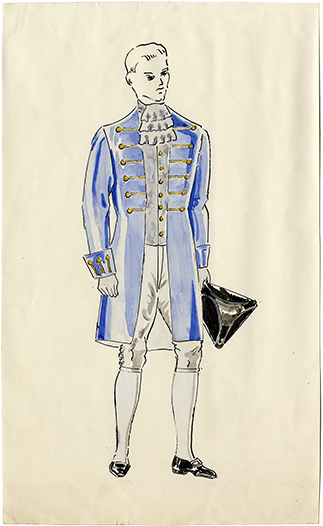
Royal Page designs for Coronation, 1953.
© E&R Archive and Collections
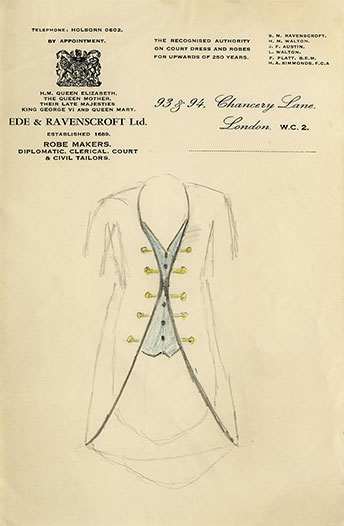
Ede & Ravenscroft has long had a reputation for using only the highest quality traditional fabrics in garment production, which continues to this day. But during the post-war period, synthetic fibre manufacturing revolutionised the mainstream dress industry by offering cheaper, more readily available alternatives. Cellulose acetate was one such fabric, produced by the Celanese company.
In 1953, just prior to the Coronation, Ede & Ravenscroft took part in a Celanese advertising campaign. Celanese ordered a coronation robe and kirtle made out of their own fabric in order to demonstrate its versatility and high quality, although failing to convince Ede & Ravenscroft of a switch away from traditional velvet.

© ILN/Mary Evans

© Victoria and Albert Museum. London

Baroness Elliott of Harwood and Baroness Ravensdale of Kedleston, two of the first four female peers created in October 1958. © Keystone Pictures USA / Alamy Stock Photo
1950s
Ede & Ravenscroft's heritage
In 1958, female peers were admitted to the House of Lords for the first time, through the Life Peerages Act.
Read More1950s
Ede & Ravenscroft's Heritage
In 1958, female peers were admitted to the House of Lords for the first time, through the Life Peerages Act. Ede & Ravenscroft was requested to produce female peers’ robes from a design proposed by Norman Hartnell, although the decision was subsequently made that men and women would wear identical parliamentary robes and the new designs were never produced.
However, a new style tricorn hat was designed and made by Ede & Ravenscroft, and the company went on to produce, store and hire out the traditional style parliamentary robes to female members of the House of Lords, as they had for many previous generations of male peers.

© ILN/Mary Evans
1960s
Ede & Ravenscroft's heritage
During the 1960s the company combined the traditional with elements of modern innovative design in its robemaking.
Read More1960s
Ede & Ravenscroft's Heritage
The Order of the British Empire is a twentieth century order of chivalry established by George V in 1917. In 1960, the Queen’s mantle of the Order of the British Empire was made by Ede & Ravenscroft to a scheme by British designer Marion Foale, while a student at the Royal College of Art.

Queen Elizabeth II and Prince Philip leaving St Paul’s Cathedral in robes of the Order of the British Empire after attending the service of dedication to the Order, 1974.
© Reginald Davis/REX/Shutterstock

Investiture of the Prince of Wales, 1969.
© Reginald Davis/REX/Shutterstock
As for the previous Prince of Wales in 1911, the company was tasked with providing ceremonial dress for the Investiture of Prince Charles as Prince of Wales in 1969.

© Reginald Davis/REX/Shutterstock
1960s
Ede & Ravenscroft's heritage
The substantial rise in student numbers during the 1960s and the creation of a number of new universities significantly increased demand for academic dress and for the provision of new academic dress schemes.
Read More1960s
Ede & Ravenscroft's Heritage
The expansion of higher education during the latter part of the twentieth century following the 1963 Robbins Report on Higher Education heavily impacted the work of Ede & Ravenscroft. During the 1960s, Ede & Ravenscroft created new dress schemes for the new institutions created during this period, often in association with designers such as Hardy Amies. Their remit was to retain something of traditional academic dress whilst reflecting a progressive outlook through contemporary design and distinctive colour schemes.

University of Salford Chancellor’s robes, 1967.
© E&R Archive and Collections

The Open University Chancellor’s robes, design work, c1969
© E&R Archive and Collections

© E&R Archive and Collections

© E&R Archive and Collections
1960s - 1970s
Ede & Ravenscroft's heritage
The granting of independence to Commonwealth countries during the 1960s and 1970s led to a growth in overseas trade for Ede & Ravenscroft.
Read More1960s - 1970s
Ede & Ravenscroft's Heritage
During this period, Commonwealth countries formed their own executive legislatures, legal bodies and academic institutions, each requiring new schemes of dress. Ede & Ravenscroft was required to design schemes which combined aspects of British systems of dress, whilst incorporating local cultural design.
The Ghanaian Speaker of the House of Assembly’s robes (below) incorporate a front facing of kente cloth, a distinctive traditional cloth associated with Ghana. The cloth is woven on a handloom in three inch wide long strips, in various brightly coloured patterns.

Ahmadu Bello University, Nigeria, Chancellor’s robes, 1960s.
© E&R Archive and Collections

Ghana, Speaker’s robes, 1971.
© E&R Archive and Collections


1980s
Ede & Ravenscroft's heritage
The expansion of Ede & Ravenscroft’s provision of the hire and sale of academic robes during the late twentieth century required the establishment of large warehousing facilities.
Read More1980s
Ede & Ravenscroft's Heritage
The company’s first warehouse was built in the early 1980s in Waterbeach, to the north of Cambridge. During the 1990s, further warehousing facilities were established in Grangemouth, Scotland in order to service academic institutions in Scotland and the north of England.
The company’s provision of graduation services continues to operate from Waterbeach and Grangemouth.

Academic warehouse, Waterbeach, c1982.
© E&R Archive and Collections

1980s
Ede & Ravenscroft's heritage
Ede & Ravenscroft celebrated its Tercentenary in 1989 with the publication of a book on the history of the company, Robes of the Realm, and a touring exhibition.
Read More1980s
Ede & Ravenscroft's Heritage
Patrick Lichfield was commissioned to take a series of photographs for Robes of the Realm, representing the diverse aspects of ceremonial dress made by the company throughout its history.

© Lord Lichfield




© E&R Archive and Collections
1980s
Ede & Ravenscroft's heritage
The expansion of the company’s retail outlets began during the 1980s, adding ready to wear formal and casual collections, whilst maintaining the company’s tradition of providing personal and bespoke tailoring services.
Read More1980s
Ede & Ravenscroft's Heritage
The opening of an Ede & Ravenscroft branch in Cambridge was the first sales outlet to open since the Chancery Lane shop was established in 1868. Other outlets were opened in Oxford and Edinburgh during the 1990s, and during the 2000s further shops were opened in London, including the company’s first outlet on Savile Row.

© E&R Archive and Collections

Ede & Ravenscroft shop, Burlington Gardens, Savile Row.
© E&R Archive and Collections
1990s
Ede & Ravenscroft's heritage
Ede & Ravenscroft further expanded its graduation services by offering event photography for the first time during the 1990s. Ede & Ravenscroft Photography was established in 1997, providing a single point of contact for graduands to obtain both academic dress and graduation photographs.
Read More1990s
Ede & Ravenscroft's Heritage
Ede & Ravenscroft’s first website was developed during this period, offering online ordering and purchasing for all aspects of the business. Online ordering was particularly complementary to the company’s expanding provision of graduation services, transforming the speed in which transactions could be processed.

© E&R Archive and Collections

© E&R Archive and Collections

© Greg Funnell
2000s
Ede & Ravenscroft's heritage
The 2000s saw Ede & Ravenscroft continue to incorporate modern design trends into academic dress, working with iconic British fashion designers such as Betty Barclay and Dame Vivienne Westwood.
Read More2000s
Ede & Ravenscroft's Heritage
In 2007 King’s College London was granted degree awarding powers and required a new scheme of academic dress. Ede & Ravenscroft worked closely with Vivienne Westwood in order to create a distinctive and contemporary design which incorporated gold King’s Lion buttons on each shoulder, with the hood fastened to the buttons, and the cowl bindings with the relevant school colour extending down the front of the gown.

© Greg Funnell

Duke of Edinburgh, Honorary Doctorate robe, London Metropolitan University, 2003.
© E&R Archive and Collections
London Metropolitan University’s strikingly modern silver and purple colour scheme was incorporated into their academic dress, as shown here in the Duke of Edinburgh’s honorary doctorate robe. As the then patron, he was awarded the first degree given by the new university in 2003.
2010s
Ede & Ravenscroft's heritage
Having outgrown premises in Peterborough, in 2013 the company created new state of the art photography laboratory facilities near Cambridge, allowing further improvements to be made to its photographic services.

2010s
Ede & Ravenscroft's heritage
In 2014 a purpose-built archive strongroom was established to house Ede & Ravenscroft’s wealth of historic written records, documenting the activities of the business from 1741.
Read More2010s
Ede & Ravenscroft's Heritage
In order to ensure the preservation of Ede & Ravenscroft’s corporate legacy, the company set up a formalised management of its archive and dress collections during the 2010s. The collections represent a vital resource for the history of the company, and for wider aspects of business and social history, documenting ceremonial dress and custom over a period of almost 300 years.


Cancel Ceremony Attendance
You have changed your response to NOT attending
Do you wish to cancel all your academic hire dress too (you will need to proceed through the checkout the confirm)?








